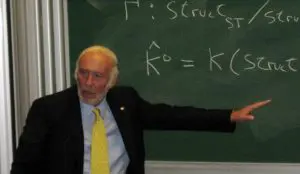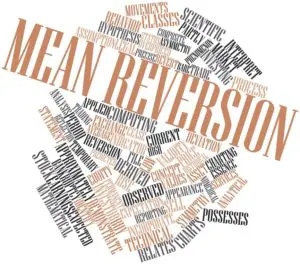Gregory Zuckerman’s new book, The Man Who Solved the Market: How Jim Simons Launched the Quant Revolution, is a terrific book.
When Zuckerman set out to write a book about Jim Simons’s Renaissance Technologies, Simons and others made it clear to Zuckerman not to expect any help from them. Zuckerman wasn’t surprised. He knew that Simons and team were among the most secretive traders in Wall Street history. Zuckerman writes:
There were compelling reasons I was determined to tell Simons’s story. A former math professor, Simons is arguably the most successful trader in the history of modern finance. Since 1988, Renaissance’s flagship Medallion hedge fund has generated average annual returns of 66 percent… No one in the investment world comes close. Warren Buffett, George Soros, Peter Lynch, Steve Cohen, and Ray Dalio all far short…
Zuckerman adds:
Simons’s pioneering methods have been embraced in almost every industry, and reach nearly every corner of everyday life. He and his team were crunching statistics, turning tasks over to machines, and relying on algorithms more than three decades ago–long before these tactics were embraced in Silicon Valley, the halls of government, sports stadiums, doctors’ offices, military command centers, and pretty much everywhere else forecasting is required.
With persistence, Zuckerman ended up doing over four hundred interviews with more than thirty current and former Renaissance employees. And he did interviews with a larger number of friends, family members, and others. Zuckerman:
I owe deep gratitude to each individual who spent time sharing memories, observations, and insights. Some accepted substantial personal risk to help me tell this story. I hope I rewarded their faith.
(Jim Simons, by Gert-Martin Greuel, via Wikimedia Commons)
Part One: Money Isn’t Everything
CHAPTER ONE
In the winter of 1952, Jimmy Simons was fourteen years old. He was trying to earn spending money at Breck’s garden supply near Newton, Massachusetts, where his home was. Jimmy was absent-minded and misplaced almost everything. So the owners asked him to sweep the floor. A few weeks later, having finished the Christmas-time job, the owners asked Jimmy what he wanted to do. He replied:
I want to study mathematics at MIT.
Breck’s owners burst out laughing. How could someone so absent-minded study mathematics? And at MIT? Zuckerman writes:
The skepticism didn’t bother Jimmy, not even the giggles. The teenager was filled with preternatural confidence and an unusual determination to accomplish something special, the result of supportive parents who had experienced both high hopes and deep regrets in their own lives.
Jimmy remained an only child of Marcia and Matthew Simons after Marcia endured a series of miscarriages.
A sharp intellect with an outgoing personality and subtle wit, Marcia volunteered in Jimmy’s school but never had the opportunity to work outside the home. She funneled her dreams and passions into Jimmy, pushing him academically and assuring him that success was ahead.
Matty Simons was a sales manager for 20th Century Fox. He loved the job. But then his father-in-law, Peter Kantor, asked him to work at his shoe factory. Peter promised Matty an ownership stake. Matty felt obliged to join the family business. Zuckerman:
Matty Simons spent years as the general manager of the shoe factory, but he never received the ownership share Peter had promised. Later in life, Matty told his son he wished he hadn’t forgone a promising and exciting career to do what was expected of him.
Simons says the lesson he learned was to do what you like in life, not what you think you ‘should’ do. Simons never forgot this lesson.
Even as a young kid, Simons loved to think, often about mathematics. Zuckerman:
Unlike his parents, Jimmy was determined to focus on his own passions. When he was eight, Dr. Kaplan, the Simons family doctor, suggested a career in medicine, saying it was the ideal profession “for a bright Jewish boy.”
Jimmy bristled.
“I want to be a mathematician or a scientist,” he replied.
The doctor tried to reason with the boy. “Listen, you can’t make any money in mathematics.”
Jimmy said he wanted to try.
Zuckerman continues:
He loved books, frequently visiting a local library to take out four a week, many well above his grade level. Mathematical concepts captivated him most, however.
After finishing high school in three years, the seventeen-year-old took a trip across the country with a friend. One thing they encountered was severe poverty, which made them more sensitive to the predicaments of society’s disadvantaged.
Soon Simons enrolled at MIT.
(MIT logo, via Wikimedia Commmons)
He skipped the first year of mathematics because he had taken advanced-placement courses in high school. Zuckerman:
Overconfident during the second semester of his freshman year, Simons registered for a graduate course in abstract algebra. It was an outright disaster. Simons was unable to keep up with the classmates and couldn’t understand the point of the assignments and course topics.
Simons bought a book on the subject and took it home for the summer, reading and thinking for hours at a time. Finally, it clicked. Simons aced subsequent algrebra classes. Though he received a D in an upper-level calculus course in his sophomore year, the professor allowed him to enroll in the next level’s class, which discussed Stokes’ theorem, a generalization of Isaac Newton’s fundamental theorem of calculus that relates line integrals to surface integrals in three dimensions. The young man was fascinated–a theorem involving calculus, algebra, and geometry seemed to produce simple, unexpected harmony. Simons did so well in the class that students came to him seeking help.
“I just blossomed,” Simons says. “It was a glorious feeling.”
Simons loved the beauty of mathematics. Although Simons realized he wasn’t quite the best, he had an imaginative approach to problems and an instinct to focus on the kinds of problems that might lead to breakthroughs.
When Simons returned to MIT to begin his graduate studies, his advisor suggested he finish his PhD at the University of California, Berkeley, so he could work with a professor named Shiing-Shen Chern, a former math prodigy from China and a leading differential geometer and topologist.
Meanwhile, he had met an eighteen-year-old named Barbara Bluestein. They talked a great deal and eventually decided to get engaged. Over strong objections from her parents, Barbara decided to go with Simons to Berkeley. The pair got married in Reno, Nevada. Simons used the money they had left after the marriage to play poker. He won enough to buy Barbara a black bathing suit.
Back at Berkeley:
…Simons made progress on a PhD dissertation focused on differential geometry–the study of curved, multidimensional spaces using methods from calculus, topology, and linear algebra. Simons also spent time on a new passion: trading. The couple had received $5,000 as a wedding gift, and Simons was eager to multiply the cash.
Simons bought a couple of stocks. But they didn’t move and he asked a broker if they had anything “more exciting.” The broker suggested soybeans.
Simons knew nothing about commodities or how to trade futures… but he became an eager student. At the time, soybeans sold for $2.50 per bushel. When the broker said Merrill Lynch’s analysts expected prices to go to three dollars or even higher, Simons’s eyes widened. He bought two futures contracts, watched soybeans soar, and scored several thousand dollars of profits in a matter of days.
Simons was hooked.
“I was fascinated by the action and the possibility I could make money short-term,” he says.
After a respected journal published Simons’s dissertation, he won a prestigious, three-year teaching position at MIT. However, Simons began to worry that his whole life would be research and teaching.
“Is this it? Am I going to do this my whole life?” he asked Barbara one day at home. “There has to be more.”
In 1963, Simons accepted a research position at Harvard.
CHAPTER TWO
Zuckerman writes:
In 1964, Simons quit Harvard University to join an intelligence group helping to fight the ongoing Cold War with the Soviet Union. The group told Simons he could continue his mathematics research as he worked on government assignments. Just as important, he doubled his previous salary and began paying off his debts.
Simons’s offer came from the Princeton, New Jersey, division of the Institute for Defense Analyses, an elite research organization that hired mathematicians from top universities to assist the National Security Agency–the United States’ largest and most secretive intelligence agency–in detecting and attacking Russian codes and ciphers.
…The IDA taught Simons how to develop mathematical models to discern and interpret patterns in seemingly meaningless data. He began using statistical analysis and probability theory, mathematical tools that would influence his work.
Simons learned that he liked making algorithms and testing things out on a computer. Simons became a sleuthing star.

Also, Simons learned by seeing how the group recruited new researchers. The recruits were identified by brainpower, creativity, and ambition, rather than for any particular expertise or background. Simons met Lenny Baum, one of the most-accomplished code breakers. Baum developed a saying that became the group’s credo:
“Bad ideas is good, good ideas is terrific, no ideas is terrible.”
Zuckerman notes:
The team routinely shared credit and met for champagne toasts after discovering solutions to particularly thorny problems. Most days, researchers wandered into one another’s offices to offer assistance or lend an ear. When staffers met each day for afternoon tea, they discussed the news, played chess, worked on puzzles, or competed at Go, the complicated Chinese board game.
Simons and his wife threw regular dinner parties at which IDA staffers became inebriated on Barbara’s rum-heavy Fish House Punch. The group played high-stakes poker matches that lasted until the next morning, with Simons often walking away with fistfuls of his colleagues’ cash.

Meanwhile, Simons was making progress in his research on minimal varieties, a subfield of differential geometry in which he long had an interest. Zuckerman:
He was hoping to discover and codify universal principles, rules, and truths, with the goal of furthering the understanding of these mathematical objects. Albert Einstein argued that there is a natural order in the world; mathematicians like Simons can be seen as searching for evidence of that structure. There is true beauty to their work, especially when it succeeds in revealing something about the universe’s natural order. Often, such theories find practical applications, even many years later, while advancing our knowledge of the universe.
Eventually, a series of conversations with Frederick Almgren Jr., a professor at nearby Princeton University who had solved the problem in three dimensions, helped Simons achieve a breakthrough. Simons created a partial differential equation of his own, which became known as the Simons equation, and used it to develop a uniform solution through six dimensions…
In 1968, Simons published “Minimal Varieties in Riemannian Manifolds,” which became a foundational paper for geometers, proved crucial in related fields, and continues to garner citations, underscoring its enduring significance. These achievements helped establish Simons as one of the world’s preeminent geometers.
At the same time, Simons was studying the stock market in an effort to figure out how to make money. Collaborating with Baum and two other colleagues, Simons developed a stock-trading system. Simons and his colleagues ignored fundamental information such as earnings, dividends, and corporate news. Instead, they searched for “macroscopic variables” that could predict the short-term behavior of the stock market.
Here’s what was really unique: [They] didn’t try to identify or predict these states using economic theory or other conventional methods, nor did the researchers seek to address why the market entered certain states. Simons and his colleagues used mathematics to determine the set of states best fitting the observed pricing data; their model then made its bets accordingly. The whys didn’t matter, Simons and his colleagues seemed to suggest, just the strategies to take advantage of the inferred states.
Simons and his colleagues used a mathematical tool called a hidden Markov model.
(Hidden Markov models, via Wikimedia Commons)
Also, they weren’t alone. For instance, mathematician Ed Thorp developed an early form of computerized trading.
***
Simons was really good at identifying the most promising ideas of his colleagues. Soon, he was in line to become deputy director of IDA. Then came the Vietnam war. Simons wrote a six-paragraph letter to The New York Times, arguing that there were better uses of the nation’s resources than the Vietnam war. As a result, IDA fired Simons.
A friend asked Simons what his ideal job was. Simons said he’d like to be the chair of a large math department, but he was too young and didn’t know the right people. The friend told Simons that he had an idea. Soon thereafter, Simons received a letter from John Toll, president of SUNY Stony Brook, a public university on Long Island. The school had already spent five years looking for someone to chair its math department.
Toll was leading a $100 million, government-funded push to make SUNY Stony Brook the “Berkeley of the East.”
In 1968, Simons moved his family to Long Island and he began recruiting. One person he targeted was a Cornell University mathematician named James Ax, who had won the prestigious Cole Prize in number theory. Simons and Ax had been friendly as graduate students at Berkeley. Simons charmed Ax into moving to Stony Brook. Zuckerman:
Ax’s decision sent a message that Simons meant business. As he raided other schools, Simons refined his pitch, focusing on what it might take to lure specific mathematicians. Those who valued money got raises; those focused on personal research got lighter class loads, extra leave, generous research support, and help evading irritating administrative requirements.
Meanwhile, Simons’s marriage to Barbara was struggling. They eventually divorced. Barbara went on to earn a PhD in computer science at Berkeley in 1981. Subsequently, she had a distinguished career. Asked about her marriage to Simons, she reflected that they had gotten married when they were too young.
Now alone on Long Island, Simons sought a nanny to help when his three children were at his house. That’s how he met Marilyn Hawrys, a twenty-two-year-old blond who later became a graduate student in economics at Stony Brook. Simons asked her on a date, and they started seeing each other.
Around this time, Simons made a breakthrough with Shiing-Shen Chern.
On his own, Simons made a discovery related to quantifying shapes in curved, three-dimensional spaces. He showed his work to Chern, who realized the insight could be extended to all dimensions. In 1974, Chern and Simons published “Characteristic Forms and Geometric Invariants,” a paper that introduced Chern-Simons invariants… which proved useful in various aspects of mathematics.
In 1976, at the age of thirty-seven, Simons was awarded the American Mathematical Society’s Oswald Veblen Prize in Geometry, the highest honor in the field, for his work with Chern and his earlier research in minimal varieties. A decade later, theoretical physicist Edward Witten and others would discover that Chern-Simons theory had applications to a range of areas in physics, including condensed matter, string theory, and supergravity. It even became crucial to methods used by Microsoft and others in their attempts to develop quantum computers capable of solving problems vexing modern computers, such as drug development and artificial intelligence. By 2019, tens of thousands of citations in academic papers–approximately three a day–referenced Chern-Simons theory, cementing Simons’s position in the upper echelon of mathematics and physics.
Simons was ready for a new challenge. He had recently invested money with Charlie Freifeld, who had taken a course from Simons at Harvard. Freifeld used econometric models to predict the prices of commodities. Soon Simons’s investment with Freifeld had increased tenfold. This got Simons’s excited again about the challenge of investing.
In 1978, Simons left academia to start an investment firm focused on currency trading. (World currencies had recently been allowed to float.) Some academics thought that Simons was squandering a rare talent.
CHAPTER THREE
Early summer of 1978, a few miles down the road from Stony Brook University:
Simons sat in a storefront office in the back of a dreary strip mall. He was next to a woman’s clothing boutique, two doors down from a pizza joint, and across from the tiny, one-story Stony Brook train station. His space, built for a retail establishment, had beige wallpaper, a single computer terminal, and spotty phone service. From his window, Simons could barely see the aptly named Sheep Pasture Road, an indication of how quickly he had gone from broadly admired to entirely obscure.
The odds weren’t in favor of a forty-year-old mathematician embarking on his fourth career, hoping to revolutionize the centuries-old world of investing.
Simons hadn’t shown any real talent in investing. He acknowledged that his investment with Freifeld had been “completely lucky.”

They only held on to the profits because they had agreed to cash out if they ever made a large amount. Weeks after they sold their position, sugar prices plummeted, which neither Freifeld nor Simons had predicted. They had barely avoided disaster. Zuckerman:
Somehow, Simons was bursting with self-confidence. He had conquered mathematics, figured out code-breaking, and built a world-class university department. Now he was sure he could master financial speculation, partly because he had developed a special insight into how financial markets operated.
[…]
It looks like there’s some structure here, Simons thought.
He just had to find it.
Simons decided to treat financial markets like any other chaotic system. Just as physicists pore over vast quantities of data and build elegant models to identify laws in nature, Simons would built mathematical models to identify order in financial markets. His approach bore similarities to the strategy he had developed years earlier at the Institute for Defense Analyses, when he and his colleagues wrote the research paper that determined that markets existed in various hidden states that could be identified with mathematical models. Now Simons would test the approach in real life.
Simons named his company Monemetrics, combining “money” and “econometrics.” He then began a process he knew well: hiring a team of big brains. Zuckerman:
He did have an ideal partner in mind for his fledgling firm: Leonard Baum, one of the coauthors of the IDA research paper and a mathematician who had spent time discerning hidden states and making short-term predictions in chaotic environments. Simons just had to convince Baum to risk his career on Simons’s radical, unproven approach.
Baum’s parents had fled Russia for Brooklyn to escape poverty and anti-Semitism. In high school, Baum was six feet tall and his school’s top sprinter. He also played tennis. Baum graduated Harvard University in 1953 and then earned a PhD in mathematics. Zuckerman:
After joining the IDA in Princeton, Baum was even more successful breaking code than Simons, receiving credit for some of the unit’s most important, and still classified, achievements.
[…]
Balding and bearded, Baum pursued math research while juggling government assignments, just like Simons. Over the course of several summers in the late 1960s, Baum and Lloyd Welch, an information theorist working down the hall, developed an algorithm to analyze Markov chains, which are sequences of events in which the probability of what happens next depends only on the current state, not past events. In a Markov chain, it is impossible to predict future steps with certainty, yet one can observe the chain to make educated guesses about possible outcomes…
A hidden Markov process is one in which the chain of events is governed by unknown, underlying parameters or variables. One sees the results of the chain but not the “states” that help explain the progression of the chain… Some investors liken financial markets, speech recognition patterns, and other complex chains of events to hidden Markov models.
The Baum-Welch algorithm provided a way to estimate probabilities and parameters within these complex sequences with little more information than the output of the processes…
Baum usually minimized the importance of his accomplishment. Today, though, Baum’s algorithm, which allows a computer to teach itself states and probabilities, is seen as one of the twentieth century’s notable advances in machine learning, paving the way for breakthroughs affecting the lives of millions in fields from genomics to weather prediction. Baum-Welch enabled the first effective speech recognition system and even Google’s search engine.
Zuckerman again:
Baum began working with Simons once a week. By 1979, Baum, then forty-eight years old, was immersed in trading, just as Simons had hoped. A top chess player in college, Baum felt he had discovered a new game to test his mental faculties. He received a one-year leave of absence from the IDA and moved his family to Long Island and a rented, three-bedroom Victorian house lined with tall bookcases…
It didn’t take Baum long to develop an algorithm directing Monemetrics to buy currencies if they moved a certain level below their recent trend line and sell if they veered too far above it. It was a simple piece of work, but Baum seemed on the right path, instilling confidence in Simons.
Zuckerman adds:
Baum became so certain their approach would work, and so hooked on investing, that he quit the IDA to work full-time with Simons.
Baum would receive 25 percent of the company’s profits. Simons would test strategies in Monemetrics. If they worked, he would implement them in a limited investment partnership he launched called Limroy, which included money from outside investors. Simons had tried to raise $4 million and had gotten close enough that he felt ready to launch. Zuckerman:
To make sure he and Baum were on the right track, Simons asked James Ax, his prized recruit at Stony Brook, to come by and check out their strategies. Like Baum a year or so earlier, Ax knew little about investing and cared even less. He immediately understood what his former colleagues were trying to accomplish, though, and became convinced they were onto something special. Not only could Baum’s algorithm succeed in currencies, Ax argued, but similar predictive models could be developed to trade commodities, such as wheat, soybeans, and crude oil. Hearing that, Simons persuaded Ax to leave academia, setting him up with his own trading account. Now Simons was really excited. He had two of the most acclaimed mathematicians working with him to unlock the secrets of the markets and enough cash to support their efforts.
One day Baum realized that Margaret Thatcher was keeping the British pound at an unsustainably low level.

Overcome with excitement, he rushed to the office to tell Simons. They started buying as much as they could of the British pound, which shot up in value. They then made accurate predictions for the Japanese Yen, West German deutsche mark, and Swiss franc. The fund made tens of millions of dollars. Zuckerman:
After racking up early currency winnings, Simons amended Limroy’s charter to allow it to trade US Treasury bond futures contracts as well as commodities. He and Baum–who now had their own, separate investment accounts–assembled a small team to build sophisticated models that might identify profitable trades in currency, commodity, and bond markets.
Simons was having a great time, but the fun wouldn’t last.
***
Simons needed someone to program their computers. He discovered Greg Hullender, a nineteen-year-old student at the California Institute of Technology. Simons offered Hullender $9,000 a year plus a share of the firm’s profits.
Limroy proceeded to lose money for the next six months. Simons was despondent. At one point he told Hullender, “Sometimes I look at this and feel I’m just some guy who doesn’t really know what he’s doing.” Zuckerman:
In the following days, Simons emerged from his funk, more determined than ever to build a high-tech trading system guided by algorithms, or step-by-step computer instructions rather than human judgment.
[…]
The technology for a fully automated system wasn’t there yet, Simons realized, but he wanted to try some more sophisticated methods.
Simons proceeded to launch a project of gathering as much past data as possible. He got commodity, bond, and currency prices going back decades, even before World War II in some cases. Zuckerman:
Eventually, the group developed a system that could dictate trades for various commodity, bond, and currency markets.
The system produced automated trade recommendations, a step short of automated trades, but the best they could do then. But soon Simons and Baum lost confidence in their system. They couldn’t understand why the system was making certain recommendations, and also they had another losing streak.
Simons and Baum drifted towards a more traditional investing approach. They looked for undervalued investments and also tried to get the news faster than others in order to react to it before others. They were investing about $30 million at that point. Zuckerman writes:
Their traditional trading approach was going so well that, when the boutique next door closed, Simons rented the space and punched through the adjoining wall. The new space was filled with offices for new hires, including an economist and others who provided expert intelligence and made their own trades, helping to boost returns. At the same time, Simons was developing a new passion: backing promising technology companies, including an electronic dictionary company called Franklin Electronic Publishers, which developed the first hand-held computer.
In 1982, Simons changed Monemetrics’ name to Renaissance Technologies Corporation, reflecting his developing interest in these upstart companies. Simons came to see himself as a venture capitalist as much as a trader.
Meanwhile, Baum excelled by relying on his own research and intuition:
He was making so much money trading various currencies using intuition and instinct that pursuing a systematic, “quantitative” style of trading seemed a waste of time. Building formulas was difficult and time-consuming, and the gains figured to be steady but never spectacular. By contrast, quickly digesting the office’s news ticker, studying newspaper articles, and analyzing geopolitical events seemed exciting and far more profitable.
Between July 1979 and March 1982, Baum made $43 million in profits, almost double his original stake from Simons.
Baum tended to hold on to his investments when he thought that a given trend would continue. Eventually this caused a rift between Baum and Simons. For example, in the fall of 1979, both Baum and Simons bought gold around $250 an ounce.
(Photo by Daniel Schreurs)
By January 1980, gold had soared past $700. Simons sold his position, but Baum held on thinking the trend would continue. Around this time, Simons learned that people were lining up to sell their physical gold–like jewelry–to take advantage of the high prices. Simons grew concerned that the increase in supply could crush gold prices.
When he got back in the office, Simons ordered Baum to sell. Baum refused. Baum was sitting on more than $10 million in profits and gold had shot past $800 an ounce. Baum was driving Simons crazy. Finally Simons called the firm’s broker and put the phone to Baum’s ear. Simons ordered Baum: “Tell him you’re selling.” Baum finally capitulated. Within months, gold shot past $865 an ounce and Baum was complaining that Simons had cost him serious money. But just a few months later, gold was under $500.
In 1983, Federal Reserve Chair Paul Volcker predicted a decline in interest rates, and inflation appeared to be under control. Baum purchased tens of millions of dollars of US bonds. However, panic selling overcame the bond market in the late spring of 1984 amid a large increase in bond issuance by the Reagan administration.
Once again, Simons told Baum to lighten up, but Baum refused. Baum also had a huge bet that the Japanese Yen would continue to appreciate. That bet was also backfiring. Zuckerman:
When the value of Baum’s investment positions had plummeted 40 percent, it triggered an automatic clause in his agreement with Simons, forcing Simons to sell all of Baum’s holdings and unwind their trading affiliation, a sad denouement to a decades-long relationship between the esteemed mathematicians.
Ultimately, Baum was very right about US bonds. By then, Baum was only trading for himself. Baum also returned to Princeton. He was now sleeping better and he had time for mathematics. Baum focused on prime numbers and the Riemann hypothesis. Also, for fun, he traveled the United States and competed in Go tournaments.
Meanwhile, Simons was upset about the losses. He considered just focusing on technology investing. He gave clients an opportunity to withdraw, but most kept faith that Simons would figure out a way to improve results.
CHAPTER FOUR
Simons came to the conclusion that Baum’s approach, using intellect and instinct, was not a reliable way to make money. Simons commented: “If you make money, you feel like a genius. If you lose, you’re a dope.” Zuckerman:
Simons wondered if the technology was yet available to trade using mathematical models and preset algorithms, to avoid the emotional ups and downs that come with betting on markets with only intelligence and intuition. Simons still had James Ax working for him, a mathematician who seemed perfectly suited to build a pioneering computer trading system. Simons resolved to back Ax with ample support and resources, hoping something special would emerge.
Zuckerman continues:
In 1961, Ax earned a PhD in mathematics from the University of California, Berkeley, where he became friends with Simons, a fellow graduate student. Ax was the first to greet Simons and his wife in the hospital after Barbara gave birth to their first child. As a mathematics professor at Cornell University, Ax helped develop a branch of pure mathematics called number theory. In the process, he forged a close bond with a senior, tenured academic named Simon Kochen, a mathematical logician. Together, the professors tried to prove a famous fifty-year-old conjecture made by the famed Austrian mathematician Emil Artin, meeting immediate and enduring frustration. To blow off steam, Ax and Kochen initiated a weekly poker game with colleagues and others in the Ithaca, New York, area. What started as friendly get-togethers, with winning pots that rarely topped fifteen dollars, grew in intensity until the men fought over stakes reaching hundreds of dollars.
[…]
Ax spent the 1970s searching for new rivals and ways to best them. In addition to poker, he took up golf and bowling, while emerging as one of the nation’s top backgammon players.
In 1979, Ax joined Simons. First Ax looked at fundamentals. Zuckerman:
Ax’s returns weren’t remarkable, so he began developing a trading system to take advantage of his math background. Ax mined the assorted data Simons and his team had collected, crafting algorithms to predict where various currencies and commodities were headed.
[…]
Ax’s predictive models had potential, but they were quite crude. The trove of data Simons and others had collected proved of little use, mostly because it was riddled with errors and faulty prices. Also, Ax’s trading system wasn’t in any way automated–his trades were made by phone, twice a day, in the morning and at the end of the trading day.
Ax soon began to rely on a former professor: Sandor Straus earned a PhD in mathematics from Berkeley in 1972 and went to teach at Stony Brook. Straus thrived. And he wore a long ponytail with John Lennon-style glasses. In 1976, Straus joined Stony Brook’s computer center. He helped Ax and others develop computer simulations. But Straus wasn’t happy and was worried about money. Simons offered to double Straus’s salary if he joined Monemetrics as a computer specialist.
Against the consistent advice of his father and friends, Straus eventually decided to join Monemetrics. Straus began collecting a wide range of data. Zuckerman:
No one had asked Straus to track down so much information. Opening and closing prices seemed sufficient to Simons and Ax. They didn’t even have a way to use all the data Straus was gathering, and with computer-processing power still limited, that didn’t seem likely to change. But Straus figured he’d continue collecting the information in case it came in handy down the road.
Straus became somewhat obsessive in his quest to locate pricing data before others realized its potential value. Straus even collected information on stock trades, just in case Simons’s team wanted it at some point in the future. For Straus, gathering data became a matter of personal pride.
Zuckerman adds:
…No one had told Straus to worry so much about the prices, but he had transformed into a data purist, foraging and cleaning data the rest of the world cared little about.
…Some other traders were gathering and cleaning data, but no one collected as much as Strauss, who was becoming something of a data guru.
Straus’s data helped Ax improve his trading results…
Simons asked Henry Laufer, another Stony Brook mathematician, to join Monemetrics. Laufer agreed. Zuckerman:
Laufer created computer simulations to test whether certain strategies should be added to their trading model. The strategies were often based on the idea that prices tend to revert after an initial move higher or lower. Laufer would buy futures contracts if they opened at unusually low prices compared with their previous closing price, and sell if prices began the day much higher than their previous close. Simons made his own improvements to the evolving system, while insisting that the team work together and share credit.
In 1985, Ax moved to Huntington Beach, California. Ax and Straus established a new company: Axcom Limited. Simons would get 25 percent of the profits, while Ax and Straus split the remaining 75 percent. Laufer didn’t want to move west, so he returned to Stony Brook. Zuckerman writes:
By 1986, Axcom was trading twenty-one different futures contracts, including the British pound, Swiss franc, deutsche mark, Eurodollars, and commodities including wheat, corn, and sugar. Mathematical formulas developed by Ax and Straus generated most of the firm’s moves, though a few decisions were based on Ax’s judgment calls. Before the beginning of trading each day, and just before the end of trading in the late afternoon, a computer program would send an electronic message to Greg Olsen, their broker at an outside firm, with an order and some simple conditions. One example: “If wheat opens above $4.25, sell 36 contracts.”
However, Simons and the team were not finding new ways to make money, nor were they improving on their existing methods, which allowed rivals to catch up. Zuckerman:
Eventually, Ax decided they needed to trade in a more sophisticated way. They hadn’t tried using more-complex math to build trading formulas, partly because the computing power didn’t seem sufficient. Now Ax thought it might be time to give it a shot.
Ax had long believed financial markets shared characteristics with Markov chains, those sequences of events in which the next event is only dependent on the current state. In a Markov chain, each step along the way is impossible to predict with certainty, but future steps can be predicted with some degree of accuracy if one relies on a capable model…
To improve their predictive models, Ax concluded it was time to bring in someone with experience developing stochastic equations, the broader family of equations to which Markov chains belong. Stochastic equations model dynamic processes that evolve over time and can involve a high level of uncertainty.
Soon Rene Carmona, a professor at University of California, Irvine, got a call from a friend who told him a group of mathematicians was looking for someone with his specialty–stochastic differential equations. Simons, Ax, and Straus were interested. Zuckerman:
Perhaps by hiring Carmona, they could develop a model that would produce a range of likely outcomes for their investments, helping to improve their performance.
Carmona was eager to lend a hand–he was consulting for a local aerospace company at the time and liked the idea of picking up extra cash working for Axcom a few days a week. The challenge of improving the firm’s trading results also intrigued him.
“The goal was to invent a mathematical model and use it as a framework to infer some consequences and conclusions,” Carmona says. “The name of the game is not to always be right, but to be right often enough.”
In 1987, after having made little progress, Carmona decided to spend the summer working full-time for Axcom. Yet Carmona still couldn’t generate useful results. Carmona soon realized that they needed regressions that could capture nonlinear relationships in market data. Zuckerman explains:
He suggested a different approach. Carmona’s idea was to have computers search for relationships in the data Strauss had amassed. Perhaps they could find instances in the remote past of similar trading environments, then they could examine how prices reacted. By identifying comparable trading situations and tracking what subsequently happened to prices, they could develop a sophisticated and accurate forecasting model capable of detecting hidden patterns.
For this approach to work, Axcom needed a lot of data, even more than Strauss and the others had collected. To solve the problem, Strauss began to model data rather than just collect it. In other words, to deal with gaps in historical data, he used computer models to make educated guesses as to what was missing. They didn’t have extensive cotton pricing data from the 1940s, for example, but maybe creating the data would suffice…
Carmona suggested letting the model run the show by digesting all the various pieces of data and spitting out buy-and-sell decisions. In a sense, he was proposing an early machine-learning system. The model would generate predictions for various commodity prices based on complex patterns, clusters, and correlations that Carmona and the others didn’t understand themselves and couldn’t detect with the naked eye.
Elsewhere, statisticians were using similar approaches–called kernel methods–to analyze patterns in data sets.
At first, Simons couldn’t get comfortable because he couldn’t understand why the model was reaching certain conclusions. Carmona told Simons to follow the data. Ax urged Simons to let the computers do it.
(Illustration by Dmitry Gorelkin)
Zuckerman:
When the Axcom team started testing the approach, they quickly began to see improved results. The firm began incorporating higher dimensional kernel regression approaches, which seemed to work best for trending models…
Simons was convinced they could do even better. Carmona’s ideas helped, but they weren’t enough. Simons called and visited, hoping to improve Axcom’s performance, but he mostly served as the pool operator, finding wealthy investors for the fund and keeping them happy, while attending to the various technology investments that made up about half of the $100 million assets now held by the firm.
Seeking even more mathematical firepower, Simons arranged for a well-respected academic to consult with the firm. That move would lay the groundwork for a historic breakthrough.
CHAPTER FIVE
Elwyn Berlekamp attended MIT. In his senior year, Berlekamp won a prestigious math competition to become a Putnam Fellow. While pursuing a PhD at MIT, he focused on electrical engineering, studying with Peter Elias and Claude Shannon. One day Shannon pulled Berlekamp aside and told him it wasn’t a good time to invest in the stock market. Berlekamp had no money, so he laughed. Also, he thought investing was a game where rich people play and that it doesn’t do much to improve the world.
During the summers of 1960 and 1962, Berlekamp worked as a research assistant at Bell Laboratories research center in Murray Hill, New Jersey. While there, he worked for John Larry Kelly, Jr. Kelly was a brilliant physicist who had been a pilot in the US Navy in World War II. Kelly smoked six packs of cigarettes a day and invented a betting system to bet on college and professional football. Kelly invented the Kelly criterion.
The Kelly criterion can be written as follows (Zuckerman doesn’t mention this, but it’s worth noting):
-
- F = p – [q/o]
where
-
- F = Kelly criterion fraction of current capital to bet
- o = Net odds, or dollars won per $1 bet if the bet wins (e.g., the bet may pay 5 to 1, meaning you win $5 per each $1 bet if the bet wins)
- p = probability of winning
- q = probability of losing = 1 – p
The Kelly criterion has a unique mathematical property: if you know the probability of winning and the net odds (payoff), then betting exactly the percentage determined by the Kelly criterion leads to the maximum long-term compounding of capital, assuming that you’re going to make a long series of bets. Betting any percentage that is not equal to that given by the Kelly criterion will inevitably lead to lower compound growth over a long period of time.
Berlekamp finished his PhD at the University of California, Berkeley. He became an assistant professor of electrical engineering. Zuckerman:
Berlekamp became an expert in decoding digital information, helping NASA decipher images coming back from satellites exploring Mars, Venus, and other parts of the solar system. Employing principles he had developed studying puzzles and games… Berlekamp cofounded a branch of mathematics called combinatorial game theory and wrote a book called Algebraic Coding Theory, a classic in the field.
By the late 1960s, the Institute for Defense Analyses (IDA) hired Berlekamp. He met Simons, but the two didn’t hit it off, despite having both spent time at MIT, Berkeley, and IDA.
“His mathematics were different from mine,” Berlekamp says. “And Jim had an insatiable urge to do finance and make money. He likes action… He was always playing poker and fussing around with the markets.”
In 1973, Berlekamp became the part owner of a cryptography company. In 1985, Eastman Kodak acquired the company, giving Berlekamp an unexpected windfall. Berlekamp complained that the money caused challenges in his marriage. His wife wanted a bigger house, while he wanted to travel.
While trying to figure out how to invest the money, a friend told him to look at commodities. This led Berlekamp to contact Simons, who told him, “I have just the opportunity for you.” Berlekamp started flying to Huntington Beach a couple of times a month to learn to trade and to see if his expertise in statistical information theory might be useful. Zuckerman says:
For all the brainpower the team was employing, and the help they were receiving from Carmona and others, Axcom’s model usually focused on two simple and commonplace trading strategies. Sometimes, it chased prices, or bought various commodities that were moving higher or lower on the assumption that the trend would continue.

Other times, the model wagered that a price move was petering out and would reverse: a reversion strategy.
Ax had access to more extensive pricing information than his rivals, thanks to Straus’s growing collection of clean, historic data. Since price movements often resembled those of the past, that data enabled the firm to more accurately determine when trends were likely to continue and when they were ebbing. Computing power had improved and become cheaper, allowing the team to produce more sophisticated trading models, including Carmona’s kernel methods–the early, machine-learning strategy that had made Simons so uncomfortable. With those advantages, Axcom averaged annual gains of about 20 percent, topping most rivals.
Yet Simons kept asking why returns weren’t better. Adding to the tension, their rivals were multiplying.
With the Kelly criterion in mind, Berlekamp told Ax that when the odds were higher, they should make bigger bets. Ax said they would, but seemed noncommittal. Zuckerman:
Berlekamp discovered other problems with Axcom’s operations. The firm traded gold, silver, copper, and other metals, as well as hogs and other meats, and grains and other commodities. But their buy-and-sell orders were still placed through emailed instructions to their broker, Greg Olsen, at the open and close of each trading day, and Axcom often held on to investments for weeks or even months at a time.
That’s a dangerous approach, Berlekamp argued, because markets can be volatile. Infrequent trading precluded the firm from jumping on new opportunities as they arose and led to losses during extended downturns. Berlekamp urged Ax to look for smaller, short-term opportunities–get in and get out. Ax brushed him off again, this time citing the cost of doing rapid trading. Besides, Straus’s intraday price data was riddled with inaccuracies–he hadn’t fully “cleaned” it yet–so they couldn’t create a reliable model for short-term trades.
Meanwhile, some investors didn’t have faith in Simons’s venture-capital investments. So Simons closed it down in March 1988 and opened, with Ax, an offshore hedge fund focused solely on trading. They named the hedge fund Medallion because each had gotten a prestigious math award.
Within six months, Medallion was struggling. Part of it seemed to be due to the fact that Ax had gotten less focused. He moved to an isolated spot near Malibu and he rarely came in to the office even though he was managing nearly a dozen employees. Soon Ax purchased a spectacular home on a cliff in Pacific Palisades.
At one point in 1989, Medallion was down nearly 30 percent from the middle of the previous year. Simons ordered Axcom to halt all trading based on the firm’s struggling, longer-term predictive signals until Ax and his team developed a plan to improve results. In the meantime, Ax was only allowed to do short-term trading, which was just 10 percent of the fund’s activity.
Ax thought Simons’s order violated their partnership agreement. Ax was going to sue Simons. Technically, however, Axcom was trading for a general partnership controlled by Simons.
Then Berlekamp offered to buy Ax’s stake. Ax agreed. The deal left Berlekamp with a 40 percent stake in the firm, while Straus and Simons had 25 percent each. Ax still had 10 percent. But he effectively retired from trading. Ax moved to San Diego. He wrote poetry, took screenwriting classes, and wrote a science-fiction thriller.
CHAPTER SIX
Berlekamp moved the firm close to his home in Berkeley.
The team forged ahead, with Berlekamp focused on implementing some of the most promising recommendations Ax had ignored. Simons, exhausted from months of bickering with Ax, supported the idea.
“Let’s bank some sure things,” Berlekamp told Simons.
In addition to the issue of cost, short-term trading interested few investors because the gains were tiny. Zuckerman:
Berlekamp hadn’t worked on Wall Street and was inherently skeptical of long-held dogmas developed by those he suspected weren’t especially sophisticated in their analysis. He advocated for more short-term trades. Too many of the firm’s long-term moves had been duds, while Medallion’s short-term trades had proved its biggest winners, thanks to the work of Ax, Carmona, and others. It made sense to try to build on that success. Berlekamp also enjoyed some good timing–by then, most of Straus’s intraday data had been cleaned up, making it easier to develop fresh ideas for shorter-term trades.
Their goal remained the same: scrutinize historic price information to discover sequences that might repeat, under the assumption that investors will exhibit similar behavior in the future.
Berlekamp also observed that doing a higher number of shorter-term trades meant that no individual trade could hurt results. This reduces the portfolio’s risk. Berlekamp and his colleagues view Medallion as being like a casino.
“If you trade a lot, you only need to be right 51 percent of the time,” Berlekamp argued to a colleague. “We need a smaller edge on each trade.”
Zuckerman writes:
Simons and his researchers didn’t believe in spending much time proposing and testing their own intuitive trade ideas. They let the data point them to the anomalies signaling opportunity. They also didn’t think it made sense to worry about why these phenomena existed. All that mattered was that they happened frequently enough to include in their updated trading system, and that they could be tested to ensure they weren’t statistical flukes.
Zuckerman again:
Beyond the repeating sequences that seemed to make sense, the system Berlekamp, Laufer, and Straus developed spotted barely perceptible patterns in various markets that had no apparent explanation. These trends and oddities sometimes happened so quickly that they were unnoticeable to most investors. They were so faint, the team took to calling them ghosts, yet they kept reappearing with enough frequency to be worth additions to their mix of trade ideas. Simons had come around to the view that the whys didn’t matter, just that the trades worked.
[…]
By late 1989, after about six months of work, Berlekamp and his colleagues were reasonably sure their rebuilt trading system–focused on commodity, currency, and bond markets–could prosper.
[…]
The firm implemented its new approach in late 1989 with the $27 million Simons still managed. The results were almost immediate, startling nearly everyone in the office. They did more trading than ever, cutting Medallion’s average holding time to just a day and a half from a week and a half, scoring profits almost every day.
At one point, Medallion had every one of its positions with the Stotler Group, a commodity-trading firm run by Karsten Mahlmann. There were rumors Stotler was in trouble. Berlekamp wasn’t sure what to do. But Simons was. He ordered Berlekamp to move all their positions to a different broker. So he did. Soon Stotler filed for bankruptcy. Zuckerman:
Simons and his firm had narrowly escaped a likely death blow.
***
Zuckerman writes:
For much of 1990, Simons’s team could do little wrong, as if they had discovered a magic formula after a decade of fumbling around in the lab. Rather than transact only at the open and close of trading each day, Berlekamp, Laufer, and Strauss traded at noon, as well. Their system became mostly short-term moves, with long-term trades representing about 10 percent of activity.
One day, Axcom made more than $1 million, a first for the firm. Simons rewarded the team with champagne, much as the IDA’s staff had passed around flutes of bubbly after discovering solutions to thorny problems.
(Photo by William MacGregor)
Zuckerman:
Medallion scored a gain of 55.9 percent in 1990, a dramatic improvement on its 4 percent loss the previous year. The profits were especially impressive because they were over and above the hefty fees charged by the fund, which amounted to 5 percent of all assets managed and 20 percent of all gains generated by the fund.
Simons was convinced that the team had discovered a highly profitable strategy. Nonetheless, he kept messing around with trade ideas like gold. Zuckerman:
Berlekamp was baffled. It was Simons who had pushed to develop a computerized trading system free of human involvement, and it was Simons who wanted to rely on the scientific method, testing overlooked anomalies rather than using crude charts or gut instinct. Berlekamp, Laufer, and the rest of the team had worked diligently to remove humans from the trading loop as much as possible. Now Simons was saying he had a good feeling about gold prices and wanted to tweak the system?
[…]
“We must still rely on human judgment and manual intervention to cope with a drastic, sudden change,” [Simons] explained in a letter [to clients] that month.
Simons told Berlekamp how much better the fund should be doing. Simons was convinced the $40 million fund could achieve remarkable success. Berlekamp didn’t think the fund could do much better than it already had. Eventually Berlekamp–who was enjoying teaching at Berkeley more than ever–suggested to Simons that Simons buy him out. Zuckerman:
Which is exactly what Simons did. In December 1990, Axcom was disbanded; Simons purchased Berlekamp’s ownership interest for cash, while Strauss and Ax traded their Axcom stakes for shares in Renaissance, which began to manage the Medallion fund. Berlekamp returned to Berkeley to teach and do full-time math research, selling his Axcom shares at a price that amounted to six times what he had paid just sixteen months earlier…
“It never occurred to me that we’d go through the roof,” Berlekamp says.
CHAPTER SEVEN
Zuckerman writes:
Like the technical traders before him, Simons practiced a form of pattern analysis and searched for telltale sequences and correlations in market data. He hoped to have a bit more luck than investors before him by doing his trading in a more scientific manner, however. Simons agreed with Berlekamp that technical indicators were better at guiding short-term trades than long-term investments. But Simons hoped rigorous testing and sophisticated predictive models, based on statistical analysis rather than eyeballing price charts, might help him escape the fate of the chart adherents who had crashed and burned.

But Simons didn’t realize that others were busy crafting similar strategies, some using their own high-powered computers and mathematical algorithms. Several of these traders already had made enormous progress, suggesting that Simons was playing catch-up.
Zuckerman:
Edward Thorp became the first modern mathematician to use quantitative strategies to invest sizable sums of money. Thorp was an academic who had worked with Claude Shannon, the father of information theory, and embraced the proportional betting system of John Kelly, the Texas scientist who had influenced Elwyn Berlekamp.
By the late 1980s, Thorp’s fund had $300 million under management, while Simons’s Medallion fund had only $25 million. Thorp’s fund traded warrants, options, convertible bonds, and other derivative securities.
I wrote about Thorp’s autobiography,A Man for All Markets, here: https://boolefund.com/man-for-all-markets/
***
Gerry Bamburger, a computer-science graduate of Columbia University, gave technical support to Morgan Stanley’s stock traders. Zuckerman:
Bamburger sensed opportunity. If the bank created a database tracking the historic prices of various paired stocks, it could profit simply by betting on the return of these price-spreads to their historic levels after block trades or other unusual activity. Bamburger’s bosses were swayed, setting him up with half a million dollars and a small staff. Bamburger began developing computer programs to take advantage of “temporary blips” of paired shares… By 1985, he was implementing his strategy with six or seven stocks at a time, while managing $30 million, scoring profits for Morgan Stanley.
Morgan Stanley gave Bamburger a new boss: Nunzio Tartaglia, an astrophysicist. This prompted Bamburger to quit Morgan Stanley and join Ed Thorp’s hedge fund.
Meanwhile, Tartaglia renamed his group Automated Proprietary Trading (APT). Zuckerman:
New hires, including a former Columbia University computer-science professor named David Shaw and mathematician Robert Frey, improved profits. The Morgan Stanley traders became some of the first to embrace the strategy of statistical arbitrage, or stat arb…. The team’s software ranked stocks by their gains or losses over the previous weeks, for example. APT would then sell short, or bet against, the top 10 percent of the winners within an industry while buying the bottom 10 percent of the losers on the expectation that these trading patterns would revert.
Eventually, APT suffered losses. Morgan Stanley ended up shutting the group down. Zuckerman comments:
It wouldn’t be clear for many years, but Morgan Stanley had squandered some of the most lucrative trading strategies in the history of finance.
***
One of the Medallion fund’s chief competitors was a fund run by David Shaw, who had been a part of Morgan Stanley’s APT group. Zuckerman:
Shaw, a supercomputing expert, hired math and science PhDs who embraced his scientific approach to trading. He also brought on whip-smart employees from different backgrounds. English and philosophy majors were among Shaw’s favorite hires, but he also hired a chess master, stand-up comedians, published writers, an Olympic-level fencer, a trombone player, and a demolitions specialist.
Soon Shaw’s fund became successful and was managing several hundred million dollars. Jim Simons wasn’t sure what methods Shaw was using, but he did realize that he needed to hire more help in order to catch up. Simons contacted Donald Sussman, a hedge-fund manager who had helped Shaw launch his fund. Perhaps Sussman would give Simons a similar boost.
CHAPTER EIGHT
Zuckerman writes about Simons meeting with Sussman:
Simons had discarded a thriving academic career to do something special in the investing world. But, after a full decade in the business, he was managing barely more than $45 million, a mere quarter the assets of Shaw’s firm. The meeting had import–backing from Sussman could help Renaissance hire employees, upgrade technology, and become a force on Wall Street.
Simons’s presentation to Sussman went well. But in the end, because Sussman was the sole source of capital for D. E. Shaw–which was generating 40 percent returns per year–Sussman decided not to invest in Renaissance. Simons approached other potential backers, but no one would invest. Most thought it was crazy to rely on trading models generated by computers. Many also thought Simons’s fees were too high. Simons charged 5 percent of assets plus 20 percent of profits, whereas most hedge funds at the time charged 2 percent of assets plus 20 percent of profits. Perhaps most importantly, Renaissance had fewer than two years of impressive performance.
Simons knew he needed to hire more help. He turned to the mathematician Henry Laufer. Zuckerman:
Joining Stony Brook’s math department in 1971, Laufer focused on complex variables and algebraic geometry, veering away from classical areas of complex analysis to develop insights into more contemporary problems.
In 1992, Laufer joined Simons as a full-time employee. Zuckerman:
Laufer made an early decision that would prove extraordinarily valuable: Medallion would employ a single trading model rather than maintain various models for different investments and market conditions, a style most quantitative firms would embrace. A collection of trading models was simpler and easier to pull off, Laufer acknowledged. But, he argued, a single model could draw on Straus’s vast trove of pricing data, detecting correlations, opportunities, and other signals across various asset classes. Narrow, individual models, by contrast, can suffer from too little data.
Just as important, Laufer understood that a single, stable model based on some core assumptions about how prices and markets behave would make it easier to add new investments later on.
Zuckerman continues:
Simons wondered if there might be a better way to parse their data trove. Perhaps breaking the day up into finer segments might enable the team to dissect intraday pricing information and unearth new, undetected patterns. Laufer… eventually decided five-minute bars were the ideal way to carve things up. Crucially, Straus now had access to improved computer-processing power, making it easier for Laufer to compare small slices of historic data…
Laufer’s five-minute bars gave the team the ability to identify new trends, oddities, and other phenomena, or, in their parlance, nonrandom trading effects. Straus and others conducted tests to ensure they hadn’t mined so deeply into their data that they had arrived at bogus trading strategies, but many of the new signals seemed to hold up.
Zuckerman adds:
Simons was challenging them to solve yet another vexing problem: Given the range of possible trades they had developed and the limited amount of money that Medallion managed, how much should the bet on each trade? And which moves should they pursue and prioritize? Laufer began developing a computer program to identify optimal trades throughout the day, something Simons began calling his betting algorithm. Laufer decided it would be “dynamic,” adapting on its own along the way and relying on real-time analysis to adjust the fund’s mix of holdings given the probabilities of future market moves–an early form of machine learning.
Simons, with about a dozen employees, realized that he still needed to hire more people in order to take on D. E. Shaw and other top funds. One person Simons hired was mathematician and programmer Nick Patterson. His coding ability gave him an advantage over other mathematicians. He graduated from the University of Cambridge.
(Photo by Cristian Saulean)
Patterson was a strong chess player and was also a stud at poker.
(Photo by Krastiu Vasilev)
After completing graduate school, Patterson worked as a cryptologist for the British government, where he made use of Bayes’s theorem of probability.
Because computing power was expanding exponentially, Patterson thought that Simons had a chance to revolutionize investing by applying high-level math and statistics.
Patterson began working on how to reduce trading costs:
…Laufer and Patterson began developing sophisticated approaches to direct trades to various futures exchanges to reduce the market impact of each trade. Now Medallion could better determine which investments to pursue, a huge advantage as it began trading new markets and investments. They added German, British, and Italian bonds, then interest-rate contracts in London, and, later, futures on Nikkei Stock Average, Japanese government bonds, and more.
The fund began trading more frequently. Having first sent orders to a team of traders five times a day, it eventually increased to sixteen times a day, reducing the impact on prices by focusing on the periods when there was the most volume.
Medallion increased 71 percent in 1994. This was especially impressive because the Federal Reserve had hiked interest rates several times, which led to losses for many investors. Simons still didn’t know why their models were working. He told a colleague: “I don’t know why planets orbit the sun. That doesn’t mean I can’t predict them.” Zuckerman:
At the time, most academics were convinced markets were inherently efficient, suggesting that there were no predictable ways to beat the market’s return, and that the financial decision-making of individuals was largely rational. Simons and his colleagues sensed the professors were wrong. They believed investors are prone to cognitive biases, the kinds that lead to panics, bubbles, boom, and busts.
Simons didn’t realize it, but a new strain of economics was emerging that would validate his instincts. In the 1970s, Israeli psychologists Amos Tversky and Daniel Kahneman had explored how individuals make decisions, demonstrating how prone most are to act irrationally. Later, economist Richard Thaler used psychological insights to explain anomalies in investor behavior, spurring the growth of the field of behavioral economics, which explored the cognitive biases of individuals and investors.
Link to my blog post on cognitive biases: https://boolefund.com/cognitive-biases/
(Illustration by Alain Lacroix)
Link to my blog post on the psychology of misjudgment: https://boolefund.com/the-psychology-of-misjudgment/
Simons saw how successful Medallion’s updated approach was, and he remembered how difficult it was for Baum, Ax, and himself to profit from instincts. As a result, Simons committed to not overriding the model. Medallion’s model profited from the errors and overreactions of other investors. Medallion’s core assumption was that investors will behave in the future like they did in the past.
Other investors at long last began noticing Medallion’s stellar results. Some of these investors made an investment in Medallion. By that point, Medallion was sharing its track record, but it wasn’t sharing much about how their trading system worked because it didn’t want rivals to catch on.
By the end of 1993, Medallion had $280 million under management. Simons grew concerned the they wouldn’t be as profitable if they got too big. So he decided, for the time being, not to let new investors into the fund. Furthermore, Simons got even more secretive about Medallion’s trading model. Simons even pressured his investors not to divulge any information about the fund’s operations.
Zuckerman writes:
Medallion was still on a winning streak. It was scoring big profits trading futures contracts and managed $600 million, but Simons was convinced the hedge fund was in a serious bind. Laufer’s models, which measured the fund’s impact on the market with surprising precision, concluded that Medallion’s returns would wane if it managed much more money. Some commodity markets, such as grains, were just too small to handle additional buying and selling by the fund without pushing prices around. There were also limitations to how much more Medallion could do in bigger bond and currency markets.
Moreover:
Simons worried his signals were getting weaker as rivals adopted similar strategies.
Yet Simons continued to search for ways to grow the fund. There was only one way to expand: start investing in stocks. The trouble was that Medallion had never developed any model to invest in stocks profitably.
Simons’s son Paul battled a birth disorder–ectodermal dysplasia. Paul worked almost every day to strengthen his body, constantly doing push-ups and pull-ups. Paul was also an accomplished skier and endurance bicycle rider. One day Paul was taking a fast ride through Old Field Road in Setauket, near the home where he grew up. An elderly woman backed out of her driveway, out of nowhere, and crushed Paul, killing him instantly. Jim Simons and Barbara were completely devastated.
CHAPTER NINE
Zuckerman comments:
When it came to stocks, Simons seemed well out of his depth.
Most successful stock investors at the time focused on fundamentals, poring over financial statements in order to understand things such as assets, liabilities, sales, earnings, and cash flows.
Nick Patterson began a side job he liked: recruiting talent for Renaissance. Zuckerman:
One day, after reading in the morning paper that IBM was slashing costs, Patterson became intrigued. He was aware of the accomplishments of the computer giant’s speech-recognition group and thought their work bore similarity to what Renaissance was doing. In early 1993, Patterson sent separate letters to Peter Brown and Robert Mercer, deputies of the group, inviting them to visit Renaissance’s offices to discuss potential positions.
Zuckerman explains that Robert Mercer’s passion for computers had been sparked by his father Thomas:
It began the very moment Thomas showed Robert the magnetic drum and punch cards of an IBM 650, one of the earliest mass-produced computers. After Thomas explained the computer’s inner workings to his son, the ten-year-old began creating his own programs, filling up an oversize notebook. Bob carried that notebook around for years before he ever had access to an actual computer.
At Sandia High School and the University of New Mexico, Mercer was a member of the chess, auto, and Russian clubs. He was low-key, but he came alive for mathematics. In 1964, he and two classmates won top honors in a national mathematics contest. Zuckerman:
While studying physics, chemistry, and mathematics at the University of New Mexico, Mercer got a job at a weapons laboratory at the Kirkland Air Force Base eight miles away, just so he could help program the base’s supercomputer.
[…]
…Mercer spent the summer on the lab’s mainframe computer rewriting a program that calculated electromagnetic fields generated by nuclear fusion bombs. In time, Mercer found ways to make the program one hundred times faster, a real coup. Mercer was energized and enthused, but his bosses didn’t seem to care about his accomplishment. Instead of running the old computations at the new, faster speed, they instructed Mercer to run computations that were one hundred times the size. It seemed Mercer’s revved-up speed made little difference to them, an attitude that helped mold the young man’s worldview.
[…]
He turned cynical, viewing government as arrogant and inefficient.
Mercer earned a PhD in computer science from the University of Illinois, then joined IBM and its speech-recognition group in 1972.
***
Peter Brown’s father Henry Brown introduced the world’s first money-market mutual fund. Few investors showed any interest, however. Henry worked every day except Christmas in 1972, when Peter was seventeen. Zuckerman:
His lucky break came the next year in the form of a New York Times article about the fledgling fund. Clients began calling, and soon Henry and his partner were managing $100 million in their Reserve Primary Fund. The fund grew, reaching billions of dollars, but Henry resigned, in 1985, to move [with his wife] to the Brown family’s farm in a Virginia hamlet, where he raised cattle on five hundred acres.
Zuckerman continues:
Peter reserved his own ambitions for science and math. After graduating from Harvard University with an undergraduate degree in mathematics, Brown joined a unit of Exxon that was developing ways to translate spoken language into computer text, an early form of speech-recognition technology. Later, he’d earn a PhD in computer science from Carnegie Mellon University in Pittsburgh.
In 1984, Brown joined IBM’s speech-recognition group. Zuckerman:
Brown, Mercer, and their fellow mathematicians and scientists, including the group’s hard-driving leader, Fred Jelinek, viewed language very differently from the traditionalists. To them, language could be modeled like a game of chance. At any point in a sentence, there exists a certain probability of what might come next, which can be estimated based on past, common usage…

Their goal was to feed their computers with enough data of recorded speech and written text to develop a probabilistic, statistical model capable of predicting likely word sequences based on sequences of sounds…
In mathematical terms, Brown, Mercer, and the rest of Jelinek’s team viewed sounds as the output of a sequence in which each step along the way is random, yet dependent on the previous step–a hidden Markov model. A speech-recognition system’s job was to take a set of observed sounds, crunch the probabilities, and make the best possible guess about the “hidden” sequences of words that could have generated those sounds. To do that, the IBM researchers employed the Baum-Welch algorithm–codeveloped by Jim Simons’s early trading partner Lenny Baum–to zero in on the various language probabilities. Rather than manually programming in static knowledge about how language worked, they created a program that learned from data.
Mercer jumped rope to stay in shape. He had a hyper-efficient style of communication, usually saying nothing and otherwise saying only a few words. Brown, by contrast, was more approachable and animated.
Jelinek created a ruthless and fierce culture. Zuckerman:
Researchers would posit ideas and colleagues would do everything they could to eviscerate them, throwing personal jabs along the way. They’d fight it out until reaching a consensus on the merits of the suggestion… It was no-holds-barred intellectual combat.
…Brown stood out for having unusual commercial instincts, perhaps the result of his father’s influence. Brown urged IBM to use the team’s advances to sell new products to customers, such as a credit-evaluation service, and even tried to get management to let them manage a few billion dollars of IBM’s pension-fund investments with their statistical approach, but failed to garner much support.
[…]
At one point, Brown learned of a team of computer scientists, led by a former Carnegie Mellon classmate, that was programming a computer to play chess. He set out to convince IBM to hire the team. One winter day, while Brown was in an IBM men’s room, he got to talking with Abe Peled, a senior IBM research executive, about the exorbitant cost of the upcoming Super Bowl’s television commercials. Brown said he had a way to get the company exposure at a much lower cost–hire the Carnegie Mellon team and reap the resulting publicity when their machine beat a world champion in chess…
The IBM brass loved the idea and hired the team, which brought its Deep Thought program along.
Mercer was skeptical that hedge funds create good for society. But he agreed to visit Renaissance and he was impressed that the company seemed to be about science. Also, both Mercer and Brown were not paid much at IBM. Brown, for his part, became more interested when he learned that Simons’s had worked with Lenny Baum, coinventor of the Baum-Welch algorithm.
Simons offered to double their salaries. Mercer and Brown joined Renaissance in 1993.
CHAPTER TEN
Brown suggested that Renaissance interview David Magerman, whom Brown knew from IBM. Magerman’s specialty was programming, which Renaissance needed. Soon Renaissance hired Magerman.
Magerman had a difficult upbringing, growing up without much money. His father was a math whiz who’d never been able to develop his talents. He took it out on his son. Magerman was left with a desire to earn praise from people in power, some of whom Magerman saw as father figures. He also seemed to pick fights unnecessarily. Zuckerman:
“I needed to right wrongs and fight for justice, even if I was turning molehills into mountains,” Magerman acknowledges. “I clearly had a messiah complex.”
Magerman studied mathematics and computer science at the University of Pennsylvania. He excelled. Zuckerman:
At Stanford University, Magerman’s doctoral thesis tackled the exact topic Brown, Mercer, and other IBM researchers were struggling with: how computers could analyze and translate language using statistics and probability.
Although Simons had initially had Brown and Mercer working in different areas of Renaissance, the pair had been working together in their spare time on how to fix Renaissance’s stock-trading system. Soon Mercer figured out the key problem. Simons let Mercer join Brown in the stock-research area. Zuckerman:
The Brown-Mercer reunion represented a new chapter in an unusual partnership between two scientists with distinct personalities who worked remarkably well together. Brown was blunt, argumentative, persistent, loud, and full of energy. Mercer conserved his words and rarely betrayed emotion, as if he was playing a never-ending game of poker. The pair worked, though, yin with yang.
[…]
…[While at IBM, they] developed a certain work style–Brown would quickly write drafts of their research and then pass them to Mercer, a much better writer, who would begin slow and deliberate rewrites.
Brown and Mercer threw themselves into their new assignment [to revamp Renaissance’s stock-trading model.] They worked late into the evening and even went home together; during the week they shared a living space in the attic of a local elderly woman’s home, returning to their families on weekends. Over time, Brown and Mercer discovered methods to improve Simons’s stock-trading system.
Zuckerman:
[Brown and Mercer] decided to program the necessary limitations and qualifications into a single trading system that could automatically handle all potential complications. Since Brown and Mercer were computer scientists, and they had spent years developing large-scale software projects at IBM and elsewhere, they had the coding chops to build a single automated system for trading stocks.
[…]
Brown and Mercer treated their challenge as a math problem, just as they had with language recognition at IBM. Their inputs were the fund’s trading costs, its various leverages, risk parameters, and assorted other limitations and requirements. Given all those factors, they built the system to solve and construct an ideal portfolio, making optimal decisions, all day long, to maximize returns.
Zuckerman writes:
The beauty of the approach was that, by combining all their trading signals and portfolio requirements into a single, monolithic model, Renaissance could easily test and add new signals, instantly knowing if the gains from a potential new strategy were likely to top its costs. They also made their system adaptive, or capable of learning and adjusting on its own…

If the model’s recommended trades weren’t executed, for whatever reason, it self-corrected, automatically searching for buy-or-sell orders to nudge the portfolio back where it needed to be… The system repeated on a loop several times an hour, conducting an optimization process that weighed thousands of potential trades before issuing electronic trade instructions. Rivals didn’t have self-improving models; Renaissance now had a secret weapon, one that would prove crucial to the fund’s future success.
Eventually, Brown and Mercer developed an elaborate stock-trading system that featured a half million lines of code, compared to tens of thousands of lines in [the] old system. The new system incorporated all necessary restrictions and requirements; in many ways, it was just that kind of automated trading system Simons had dreamed of years earlier. Because [the] fund’s stock trades were now less sensitive to the market’s fluctuations, it began holding on to shares a bit longer, two days or so, on average.
…[The model] continued to identify enough winning trades to make serious money, usually by wagering on reversions after stocks got out of whack. Over the years, Renaissance would add twists to this bedrock strategy, but, for more than a decade, those would just be second order complements to the firm’s core reversion-to-the-mean predictive signals.
However, there were problems early on. Zuckerman:
It soon became clear that the new stock-trading system couldn’t handle much money, undermining Simons’s original purpose in pushing into equities. Renaissance placed a puny $35 million in stocks; when more money was traded, the gains dissipated… Even worse, Brown and Mercer couldn’t figure out why their system was running into so many problems.
Brown and Mercer began putting together the old team from IBM, including Magerman.
Simons gave Brown and Mercer six months to get the fund’s trading system working.
Magerman started spending all his free time trying to fix the trading system. He basically lived at the office. Eventually he identified two errors and was able to fix them. Magerman told Brown, who didn’t seem too excited. Magerman then showed Mercer, who had written all the code. Mercer checked Magerman’s work and then told him that he was right.
Brown and Mercer restarted the system and profits immediately started coming in.
CHAPTER ELEVEN
Renaissance’s trading system gained 21 percent in 1997, lower than the 32, 38, and 71 percent gained in 1996, 1995, and 1994. The system still had issues.
Simons drew on his experiences with the IDA and also from when he managed talented mathematicians at Stony Brook. One lesson Simons had learned was the importance of having researchers work together. Zuckerman:
…Medallion would have a single, monolithic trading system. All staffers enjoyed full access to each line of the source code underpinning their moneymaking algorithms, all of it readable in cleartext on the firm’s internal network. There would be no corners of the code accessible only to top executives; anyone could make experimental modifications to improve the trading system. Simons hoped his researchers would swap ideas, rather than embrace private projects…
Simons created a culture of unusual openness. Staffers wandered into colleagues’ offices offering suggestions and initiating collaborations. When they ran into frustrations, the scientists tended to share their work and ask for help, rather than move on to new projects, ensuring the promising ideas weren’t “wasted,” as Simons put it. Groups met regularly, discussing intimate details of their progress and fielding probing questions from Simons… Once a year, Simons paid to bring employees and their spouses to exotic vacation locales, strengthening the camaraderie.
Furthermore, peer pressure was used. Employees were often working on presentations, and felt the need to try to impress one another.
Simons gave all employees the chance to share in Renaissance’s profits based on clear and transparent formulas. Zuckerman notes:
Simons began sharing equity, handing a 10 percent stake in the firm to Laufer and, later, giving sizable slices to Brown, Mercer, and Mark Silber, who was now the firm’s chief financial officer, and others, steps that reduced Simons’s ownership to just over 50 percent. Other top-performing employees could buy shares, which represented equity in the firm. Staffers also could invest in Medallion, perhaps the biggest perk of them all.
Hiring wasn’t easy. To attract scientists and mathematicians, Renaissance employees would emphasize certain positive parts of their job. Solving puzzles was fun. There was camaraderie. And things moved at a fast pace. Zuckerman:
“You have money in the bank or not, at the end of the day,” Mercer told science writer Sharon McGrayne. “You don’t have to wonder if you succeeded… it’s just a very satisfying thing.”
Zuckerman continues:
By 1997, Medallion’s staffers had settled on a three-step process to discover statistically significant moneymaking strategies, or what they called their trading signals. Identify anomalous patterns in historic pricing data; make sure the anomalies were statistically significant, consistent over time, and nonrandom; and see if the identified pricing behavior could be explained in a reasonable way.
[…]
…more than half of the trading signals Simons’s team was discovering were nonintuitive, or those they couldn’t fully understand. Most quant firms ignore signals if they can’t develop a reasonable hypothesis to explain them, but Simons and his colleagues never liked spending too much time searching for the causes of market phenomena. If their signals met various measures of statistical strength, they were comfortable wagering on them. They only steered clear of the most preposterous ideas.
Zuckerman adds:
It’s not that they wanted trades that didn’t make any sense; it’s just that these were the statistically valid strategies they were finding. Recurring patterns without apparent logic to explain them had an added bonus: They were less likely to be discovered and adopted by rivals, most of whom wouldn’t touch these kinds of trades.
The danger was that unexplainable signals could be simple coincidences. Zuckerman:
Often, the Renaissance researchers’ solution was to place such head-scratching signals in their trading system, but to limit the money allocated to them, at least at first, as they worked to develop an understanding of why the anomalies appeared. Over time, they frequently discovered reasonable explanations, giving Medallion a leg up on firms that had dismissed the phenomena. They ultimately settled on a mix of sensible signals, surprising trades with strong statistical results, and a few bizarre signals so reliable they couldn’t be ignored.
Zuckerman again:
By then, Medallion increasingly was relying on strategies that its system taught itself, a form of machine learning. The computers, fed with enough data, were trained to spit out their own answers. A consistent winner, for example, might automatically receive more cash, without anyone approving the shift or even being aware of it.

Simons developed enough enthusiasm and confidence in the future of Renaissance that he moved the firm to a new office. The compound was wood and glass. Each office had a view of the woods. There was a gym, lighted tennis courts, a library with a fireplace, and a large auditorium where Simons hosted biweekly seminars from visiting scholars (usually having little to do with finance). The cafeteria and common areas were large, with plenty of whiteboards, so that staffers could meet, discuss, and debate.
Zuckerman describes Brown and Mercer:
Intense and energetic, Brown hustled from meeting to meeting, riding a unicycle through the halls and almost running over colleagues. Brown worked much of the night on a computer near the Murphy bed in his office, grabbing a nap when he tired.
[…]
Analytical and unemotional, Mercer was a natural sedative for his jittery partner. Mercer worked hard, but he liked to go home around six p.m.
One important factor of Renaissance’s success, as Zuckerman explains:
If a strategy wasn’t working, or when market volatility surged, Renaissance’s system tended to automatically reduce positions and risk.
This contrasted with many other hedge funds, including Long-Term Capital Management (LTCM), which tended to hold or to increase positions that had gone against them in the belief that they would ultimately be proved right. In the summer of 1998, LTCM blew up when its positions went against the fund. Traders at LTCM were more right than wrong, but because they had a great deal of leverage and because they maintained or increased their bets, they simply didn’t have enough capital to survive. Renaissance wouldn’t make this mistake because, as noted, the fund typically reduced positions and risk if a strategy wasn’t working or if market volatility picked up.
Despite all the improvements, Renaissance’s stock-trading system still only generated about 10 percent of the fund’s profits.
In March 2000, Medallion encountered major difficulties. Zuckerman:
It wasn’t just the mounting losses that had everyone concerned–it was the uncertainty over why things were so bad. The Medallion portfolio held commodities, currencies, and bond futures, and its stock portfolio was largely composed of offsetting positions aimed at sidestepping broad market moves. The losses shouldn’t be happening. But because so many of the system’s trading signals had developed on their own through a form of machine learning, it was hard to pinpoint the exact cause of the problems or when they might ebb; the machines seemed out of control.
Brown was freaking out and barely sleeping. Magerman felt nauseous. Mercer tried to keep his composure. But many were very worried.
Simons urged his team to stick with the model. After more all-nighters, a few researchers thought they figured out the problem. If certain stocks rallied in the preceding weeks, Medallion’s system would buy them on the expectation that the rally would continue. But as the market sold off, this momentum strategy wasn’t working at all. So the team put a halt to the fund’s momentum strategy. Immediately, Medallion began making money again. Zuckerman comments:
By the fall of 2000, word of Medallion’s success was starting to leak out. That year, Medallion soared 99 percent, even after it charged clients 20 percent of their gains and 5 percent of the money invested with Simons. Over the previous decade, Medallion and its 140 employees had enjoyed a better performance than funds managed by George Soros, Julian Robertson, Paul Tudor Jones, and other investing giants. Just as impressive, Medallion had recorded a Sharpe ratio of 2.5 in its most recent five-year period, suggesting the fund’s gains came with low volatility and risk compared with those of many competitors.
Part Two: Money Changes Everything
CHAPTER TWELVE
Zuckerman writes:
Something unusual was going on at Jim Simons’s hedge fund in 2001.
Profits were piling up as Renaissance began digesting new kinds of information. The team collected every trade order, including those that hadn’t been completed, along with annual and quarterly earnings reports, records of stock trades by corporate executives, government reports, and economic predictions and papers.
[…]
Soon, researchers were tracking newspaper and newswire stories, internet posts, and more obscure data–such as offshore insurance claims–racing to get their hands on pretty much any information that could be quantified and scrutinized for its predictive value. The Medallion fund became something of a data sponge, soaking up a terabyte, or one trillion bytes, of information annually, buying expensive disc drives and processors to digest, store, and analyze it all, looking for reliable patterns.
“There’s no data like more data,” Mercer told a colleague, an expression that became the firm’s hokey mantra.
Renaissance’s goal was to predict the price of a stock or other investment “at every point in the future,” Mercer later explained. “We want to know in three seconds, three days, three weeks, and three months.”
Zuckerman again:
It became clear to Mercer and others that trading stocks bore similarities to speech recognition, which was part of why Renaissance continued to raid IBM’s computational linguistics team. In both endeavors, the goal was to create a model capable of digesting uncertain jumbles of information and generating reliable guesses about what might come next–while ignoring traditionalists who employed analysis that wasn’t nearly as data driven.
[…]
…After soaring 98.5 percent in 2000, the Medallion fund rose 33 percent in 2001. By comparison, the S&P 500, the commonly used barometer of the stock market, managed a measly average gain of 0.2 percent over those two years, while rival hedge funds gained 7.3 percent.
Zuckerman adds:
Investment professionals generally judge a portfolio’s risk by its Sharpe ratio, which measures returns in relation to volatility; the higher one’s Sharpe, the better. For most of the 1990s, Medallion had a strong Sharpe ratio of about 2.0, double the level of the S&P 500. But adding foreign-market algorithms and improving Medallion’s trading techniques sent its Sharpe soaring to about 6.0 in early 2003, about twice the ratio of the largest quant firms and a figure suggesting there was nearly no risk of the fund losing money over a whole year.
(Holy grail, Photo by Charon)
Simons’s team appeared to have discovered something of a holy grail in investing: enormous returns from a diversified portfolio generating relatively little volatility and correlation to the overall market. In the past, a few others had developed investment vehicles with similar characteristics. They usually had puny portfolios, however. No one had achieved what Simons and his team had–a portfolio as big as $5 billion delivering this kind of astonishing performance.
Zuckerman later says:
Brown and Mercer’s staffers often spent the night programming their computers, competing to see who could stay in the office the longest, then rushing back in the morning to see how effective their changes had been. If Brown was going to push himself all day and sleep by his computer keyboard at night, his underlings felt the need to keep up…
[…]
By 2003, the profits of Brown and Mercer’s stock-trading group were twice those of Laufer’s futures team, a remarkable shift in just a few years. Rewarding his ascending stars, Simons announced that Brown and Mercer would become executive vice presidents of the entire firm, co-managing all of Renaissance’s trading, research, and technical activities.
Zuckerman:
In 2002, Simons increased Medallion’s investor fees to 36 percent of each year’s profits, raising hackles among some clients. A bit later, the firm boosted the fees to 44 percent. Then, in early 2003, Simons began kicking all his investors out of the fund. Simons had worried that performance would ebb if Medallion grew too big, and he preferred that he and his employees kept all the gains. But some investors had stuck with Medallion through difficult periods and were crushed.
Nick Simons, Jim Simons’s third-eldest son shared his father’s passions for hiking and adventure. He was taking a trip around the world before he was going to learn organic chemistry and apply for medical school. A week before he was scheduled to come home, he went freediving near Amed, a coastal strip of fishing villages in eastern Bali. While freediving, one person would be down, and the other up, in order to keep track of one another. Nick and a friend thus took turns. At one point, Nick’s friend had to go ashore to unfog his mask. When he got back out, he found Nick’s body near the bottom. They weren’t able to resuscitate him. Nick had drowned.
When Jim and Marilyn found out, they were inconsolable. Zuckerman:
In September, Jim, Marilyn, and other family members traveled to Nepal for the first time, joining some of Nick’s friends in searching for a way to continue Nick’s legacy. Nick had been drawn to Kathmandu and had an interest in medicine, so they funded a maternity ward at a hospital in the city. Later, Jim and Marilyn would start the Nick Simons Institute, which offers healthcare assistance to those living in Nepal’s rural areas, most of whom don’t have basic emergency services.
CHAPTER THIRTEEN
Medallion paid out its profits to investors–mostly its own employees by now–once per year. That helped keep the fund small enough to maintain the same high level of profitability. Simons, Henry Laufer, and others were sure that if the fund got much bigger, its profitability would suffer.
As a result, there were some profitable investments–mostly of a longer-term nature–that the fund couldn’t implement. So Simons thought that they should launch a second fund. This fund couldn’t be as profitable as Medallion; however, it could manage a lot more money than Medallion, giving outside investors a chance to invest with Renaissance.
One reason Simons wanted to launch the new fund was to give his scientists and mathematicians a new challenge. Many of them now had more money than they ever imagined, so keeping them challenged and energized was something Simons worried about.

Zuckerman:
His researchers settled on one that would trade with little human intervention, like Medallion, yet would hold investments a month or even longer. It would incorporate some of Renaissance’s usual tactics, such as finding correlations and patterns in prices, but would add other, more fundamental strategies, including buying inexpensive shares based on price-earnings ratios, balance-sheet data, and other information.
After thorough testing, the scientists determined the new hedge fund could beat the stock market by a few percentage points each year, while generating lower volatility than the overall market. It could produce the kinds of steady returns that hold special appeal for pension funds and other large institutions. Even better, the prospective fund could score those returns even if it managed as much as $100 billion, they calculated, an amount that would make it history’s largest hedge fund.
The new fund was called Renaissance Institutional Equities Fund, or RIEF. The firm emphasized to investors that the new fund wouldn’t resemble Medallion. Yet many investors ignored the warning, thinking it was the same scientists and the same research. Soon RIEF had $14 billion under management. Zuckerman:
Other than making the occasional slipup, Simons was an effective salesman, a world-class mathematician with a rare ability to connect with those who couldn’t do stochastic differential equations. Simons told entertaining stories, had a dry sense of humor, and held interests far afield from science and moneymaking. He also demonstrated unusual loyalty and concern for others, qualities the investors may have sensed.
Zuckerman adds:
By the spring of 2007, it was getting hard to keep investors away. Thirty-five billion dollars had been ploughed into RIEF, making it one of the world’s largest hedge funds… Simons made plans for other new funds, initiating work on the Renaissance Institutional Futures Fund, RIFF, to trade futures contracts on bonds, currencies, and other assets in a long-term style. A new batch of scientists was hired, while staffers from other parts of the company lent a hand, fulfilling Simons’s goal of energizing and unifying staffers.
During the summer of 2007, a few quant funds were in trouble. There was selling that seemed to be impacting all the quant funds, despite the fact that these funds thought their investment strategy was unique. The downturn became known as the “quant quake.”
Medallion was approaching the point where it could face a margin call. During the technology-stock meltdown in 2000, Brown hadn’t known what to do. But this time, he knew: Medallion should maintain, and maybe even increase, its bets. Mercer agreed with Brown. So did Henry Laufer, who said: “Trust the models–let them run.” Simons, however, disagreed. Zuckerman:
Simons shook his head. He didn’t know if his firm could survive much more pain. He was scared. If losses grew, and they couldn’t come up with enough collateral, the banks would sell Medallion’s positions and suffer their own huge losses. If that happened, no one would deal with Simons’s fund again. It would be a likely death blow, even if Renaissance suffered smaller financial losses than its bank lenders.
Medallion needed to sell, not buy, he told his colleagues.
“Our job is to survive,” Simons said. “If we’re wrong, we can always add [positions] later.”
Brown seemed shocked by what he was hearing. He had absolute faith in the algorithms he and his fellow scientists had developed…
Medallion began reducing its positions. Zuckerman again:
Some rank-and-file senior scientists were upset–not so much by the losses, but because Simons had interfered with the trading system and reduced positions…
“You’re dead wrong,” a senior researcher emailed Simons.
“You believe in the system, or you don’t,” another scientist said, with some disgust.
But Simons continued to oversee a reduction in Medallion’s positions. He wondered aloud how far the selloff could go, and he wanted to make sure Medallion survived.
Soon Simons ordered his firm to stop selling. Their positions seemed to be stabilizing. Some Renaissance scientists complained that their gains would have been larger if they had maintained their positions rather than lightening up. But Simons claimed that he would make the same decision again. Remarkably, by the end of 2007, Medallion had gained 86 percent.
***
Zuckerman writes about 2008:
…[The] Medallion fund thrived in the chaos, soaring 82 percent that year, helping Simons make over $2 billion in personal profits. The enormous gains sparked a call from a House of Representatives committee asking Simons to testify as part of its investigation into the causes of the financial collapse. Simons prepped diligently with his public-relations advisor Jonathan Gasthalter. With fellow hedge-fund managers George Soros to his right and John Paulson on his left, Simons told Congress that he would back a push to force hedge funds to share information with regulators and that he supported higher taxes for hedge-fund managers.
Simons was something of an afterthought, however, both at the hearings and in the finance industry itself. All eyes were on Paulson, Soros, and a few other investors who, unlike Simons, had successfully anticipated the financial meltdown. They did it with old-fashioned investment research, a reminder of the enduring potential and appeal of those traditional methods.
Medallion was now managing $10 billion, and had averaged 45 percent returns–net of fees–since 1988. Simons had created the best long-term track record in the world. Now, at age seventy-two, Simons decided to turn the reins over to Brown and Mercer.
CHAPTER FOURTEEN
Zuckerman:
Jim Simons liked making money. He enjoyed spending it, too.
Stepping down from Renaissance gave Simons–who, by then, was worth about $11 billion–more time on his 220-foot yacht, Archimedes. Named for the Greek mathematician and inventor, the $100 million vessel featured a formal dining room that sat twenty, a wood-burning fireplace, a spacious Jacuzzi, and a grand piano. Sometimes, Simons flew friends on his Gulfstream G450 to a foreign location, where they’d join Jim and Marilyn on the super-yacht.
Zuckerman continues:
Years earlier, Marilyn had carved out space in her dressing room to launch a family foundation. Over time, she and Jim gave over $300 million to Stony Brook University, among other institutions. As Simons edged away from Renaissance, he became more personally involved in their philanthropy. More than anything, Simons relished tackling big problems. Soon, he was working with Marilyn to target two areas in dire need of solutions: autism research and mathematics education.
In 2004, Simons helped launch Math for America, a nonprofit focused on math education and supporting outstanding teachers with annual stipends of $15,000.
Simons remained Renaissance’s chairman. At first, the transition was difficult. But soon Simons found his philanthropic goals to be challenging and engaging. Zuckerman:
…[Renaissance] now employed about 250 staffers and over sixty PhDs, including experts in artificial intelligence, quantum physicists, computational linguists, statisticians, and number theorists, as well as other scientists and mathematicians.
Astronomers, who are accustomed to scrutinizing large, confusing data sets and discovering evidence of subtle phenomena, proved especially capable of identifying overlooked market patterns…
Medallion still did bond, commodity, and currency trades, and it made money from trending and reversion-predicting signals… More than ever, though, it was powered by complex equity trades featuring a mix of complex signals, rather than simple pair trades…
Zuckerman adds:
The gains on each trade were never huge, and the fund only got it right a bit more than half the time, but that was more than enough.
“We’re right 50.75 percent of the time… but we’re 100 percent right 50.75 percent of the time,” Mercer told a friend. “You can make billions that way.”
Zuckerman continues:
Driving these reliable gains was a key insight: Stocks and other investments are influenced by more factors and forces than even the most sophisticated investors appreciated…
[…]
…By analyzing and estimating hundreds of financial metrics, social media feeds, barometers of online traffic, and pretty much anything that can be quantified and tested, they uncovered new factors, some borderline impossible for most to appreciate.
“The inefficiencies are so complex they are, in a sense, hidden in the markets in code,” a staffer says. “RenTec decrypts them. We find them across time, across risk factors, across sectors and industries.”
Even more important: Renaissance concluded that there are reliable mathematical relationships between all these forces. Applying data science, the researchers achieved a better sense of when various factors were relevant, how they interrelated, and the frequency with which they influenced shares. They also tested and teased out subtle, nuanced mathematical relationships between various shares–what staffers call multidimensional anomalies–that other investors were oblivious to or didn’t fully understand.

Zuckerman quotes a Renaissance employee:
“There is no individual bet we make that we can explain by saying we think one stock is going to go up or another down,” a senior staffer says. “Every bet is a function of all the other bets, our risk profile, and what we expect to do in the near and distant future. It’s a big, complex optimization based on the premise that we predict the future well enough to make money from our predictions, and that we understand risk, cost, impact, and market structure well enough to leverage the hell out of it.”
Renaissance also excelled at disguising its buying and selling so that others wouldn’t know what it was doing. This helped to minimize the costs of trading.
***
Bob Mercer, while being highly intelligent, surprised his colleagues with political views that didn’t seem to be based on much evidence or critical thinking. Of course, part of this could be that Mercer’s colleagues tended to have a liberal bias. In any case, Mercer was a Rational Rifle Association member who believed in guns and gold. Mercer didn’t like taxes and he was a skeptic of climate change.
Furthermore, Mercer emerged as a key donor to right-wing causes. Unusually, while most big contributors wanted something in return from politicians, Mercer didn’t ask for anything in return. Zuckerman:
Mercer’s penchant for privacy limited his activity, however, as did his focus on Renaissance. It was his second-oldest daughter, Rebekah, who started showing up at conservative fund-raising events and other get-togethers, becoming the family’s public face, and the one driving its political strategy.
Zuckerman continues:
…in 2011, the Mercers met conservative firebrand Andrew Breitbart at a conference. Almost immediately, they were intrigued with his far-right news organization, Breitbart News Network, expressing interest in funding its operations. Breitbart introduced the Mercers to his friend, Steve Bannon, a former Goldman Sachs banker, who drew up a term sheet under which the Mercer family purchased nearly 50 percent of Breitbart News for $10 million.
In March 2012, Breitbart collapsed on a Los Angeles sidewalk and died of heart failure at the age of forty-three. Bannon and the Mercers convened an emergency meeting in New York to determine the network’s future, and decided that Bannon would become the site’s executive chairman. Over time, the site became popular with the “alt-right,” a loose conglomeration of groups, some of which embraced tenets of white supremacy and viewed immigration and multiculturalism as threats.
[…]
Bannon helped broker a deal for Mercer to invest in an analytics firm called Cambridge Analytica, the US arm of the British behavioral research company SCL Group. Cambridge Analytica specialized in the kinds of advanced data Mercer was accustomed to parsing at Renaissance, and the type of information that Rebekah said the GOP lacked.
Zuckerman writes:
In February 2014, Mercer and other conservative political donors gathered at New York’s Pierre hotel to strategize about the 2016 presidential election. He told attendees he had seen data indicating that mainstream Republicans, such as Jeb Bush and Marco Rubio, would have difficulty winning. Only a true outsider with a sense of the voters’ frustrations could emerge victorious, Mercer argued.
At a gathering of GOP backers who were going to meet Trump, Rebekah walked straight to Trump. Zuckerman:
“It’s bad,” Trump acknowledged.
“No, it’s not bad–it’s over,” she told Trump. “Unless you make a change.”
Rebekah told Trump to bring in Steve Bannon and Kellyanne Conway. Zuckerman:
Before long, Bannon was running the campaign, and Conway was its manager, becoming a ubiquitous and effective television presence. Bannon helped instill order on the campaign, making sure Trump focused on two things–disparaging Clinton’s character and promoting a form of nationalism that Bannon branded “America First” …
***
Meanwhile, Jim Simons was supporting Democrats. Zuckerman says:
Ever since he and his childhood friend, Jim Harpel, had driven across the country and witnessed some of the hardships experienced by minorities and others, Simons had leaned left politically…. By the middle of 2016, Simons had emerged as the most important supporter of the Democratic Party’s Priorities USA Action super PAC and a key backer of Democratic House and Senate candidates. By the end of that year, Simons would donate more than $27 million to Democratic causes. Marilyn Simons was even more liberal than her husband, and Jim’s son, Nathaniel, had established a nonprofit foundation focused on climate change mitigation and clean-energy policy, issues the Trump campaign generally mocked or ignored.
Associates and others at Renaissance began asking Jim Simons if he could do anything about Mercer’s political activities. But Mercer had always been pleasant and respectful to Simons. Zuckerman:
“He’s a nice guy,” he insisted to a friend. “He’s allowed to use his money as he wishes. What can I do?”
CHAPTER FIFTEEN
Zuckerman writes:
Rebekah Mercer was emerging as a public figure in her own right… GQ named Mercer the seventeenth most powerful person in Washington, DC, calling her “the First Lady of the alt-right.” The family’s political clout, along with its ongoing support for the president-elect, seemed assured.
David Magerman was unhappy with Bob Mercer’s support of Trump. Magerman thought that much of what Trump was doing was harming the country. Eventually, he did an interview with Gregory Zuckerman of The Wall Street Journal. Magerman didn’t hold back. Soon after that, he got a call from Renaissance telling him he was suspended without pay.
The Mercers were facing other consequences of their political activities. Zuckerman:
At one point, the New York State Democratic Committee ran a television advertisement flashing Bob and Rebekah Mercer’s faces on the screen, saying they were the “same people who bankrolled Trump’s social media bot army and Steve Bannon’s extremist Breitbart News.”
In March 2017, about sixty demonstrators gathered outside Mercer’s home, decrying his funding of far-right causes and calling for higher taxes on the wealthy. A week later, a second group held a protest, some holding signs reading: “Mercer Pay Your Taxes.”
[…]
The Mercers received death threats, friends said, forcing the family to hire security. For a family that relished its privacy, their growing infamy was both shocking and disturbing.
Magerman felt some uncertainty about whether his public criticism of his boss was the right move. Zuckerman:
Magerman had mixed feelings of his own. He had made so much money at the firm that he didn’t have to worry about the financial pain of getting fired. He loathed what Mercer was doing to the country and wanted to stop his political activity. But Magerman also remembered how kind Mercer and his wife had been to him when he first joined the firm, inviting him to dinners at Friendly’s and movie nights with their family. Magerman respected Bob for his intelligence and creativity, and a big part of him still yearned to please the powerful men in his life. At that point, Magerman had spent two decades at Renaissance and he felt an appreciation for the firm. He decided that if he could go on speaking about Mercer’s politics, he’d return to his old job.
Magerman decided to attend a poker tournament at New York’s St. Regis hotel benefitting Math for America.

He wanted to reintroduce himself to key Renaissance people. Zuckerman:
The event was a highly anticipated annual showdown for quants, professional poker players, and others. Magerman knew Simons, Mercer, Brown, and other Renaissance executives would be there.
Rebekah Mercer was there, too. Magerman tried to approach her, and she started yelling at him. Zuckerman:
“How could you do this to my father? He was so good to you,” she said.
[…]
“You’re pond scum,” Mercer told him, repeatedly. “You’ve been pond scum for twenty-five years. I’ve always known it.”
Get out of here, she told Magerman.
Soon security forced Magerman to leave. Shortly thereafter, Renaissance fired Magerman.
Meanwhile, criticism of Renaissance grew, focused on Mercer. Zuckerman:
…nearly fifty protesters picketed the hedge fund itself, saying Mercer was their target, adding to the discomfort of executives, who weren’t accustomed to such negative publicity.
By October 2017, Simons was worried the controversy was jeopardizing Renaissance’s future. The firm’s morale was deteriorating.
Finally, Simons made the difficult decision to ask Mercer to step down from his co-CEO role.
Overall, while the Mercers pulled back on many activities, they seemed to be happy with Trump. Zuckerman:
The Mercers told friends they were happy the Trump administration had cut taxes and chosen conservative judges, among other moves, suggesting they didn’t regret becoming so involved in national politics.
CHAPTER SIXTEEN
In late December 2018, the stock market was collapsing. The S&P 500 Index fell almost 10 percent during that month, the worst December since 1931. Simons was worried. He called Ashvin Chhabra, who runs Euclidean Capital, a firm that manages Simons’s money. Simons asked Chhabra whether they should sell short. Chhabra suggested they wait until the market calmed down before considering whether to do anything. Simons agreed.
Zuckerman comments:
Hanging up, neither Simons nor Chhabra focused on the rich irony of their exchange. Simons had spent more than three decades pioneering and perfecting a new way to invest. He had inspired a revolution in the financial world, legitimizing a quantitative approach to trading. By then, it seemed everyone in the finance business was trying to invest the Renaissance way: digesting data, building mathematical models to anticipate the direction of various investments, and employing automated trading systems. The establishment had thrown in the towel. Today, even banking giant JP Morgan Chase puts hundreds of its new investment bankers and investment professionals through mandatory coding lessons. Simons’s success had validated the field of quantitative investing.
[…]
The goal of quants like Simons was to avoid relying on emotions and gut instinct. Yet, that’s exactly what Simons was doing after a few difficult weeks in the market. It was a bit like Oakland A’s executive Billy Beane scrapping his statistics to draft a player with the clear look of a star.
Zuckerman continues:
Simons’s phone call is a stark reminder of how difficult it can be to turn decision-making over to computers, algorithms, and models–even, at times, for the inventors of these very approaches. His conversation with Chhabra helps explain the faith investors have long placed in stock-and-bond pickers dependent on judgment, experience, and old-fashioned research.
By 2019, however, confidence in the traditional approach had waned. Years of poor performance had investors fleeing actively managed stock-mutual funds, or those professing an ability to beat the market’s returns. At that point, these funds, most of which embrace traditional approaches to investing, controlled just half of the money entrusted by clients in stock-mutual funds, down from 75 percent a decade earlier. The other half of the money was in index funds and other so-called passive vehicles, which simply aim to match the market’s returns, acknowledging how challenging it is to top the market.
Zuckerman later notes:
There are reasons to think the advantages that firms like Renaissance enjoy will only expand amid an explosion of new kinds of data that their computer-trading models can digest and parse. IBM has estimated that 90 percent of the world’s data sets have been created in the last two years alone, and that forty zettabytes–or forty-four trillion gigabytes–of data will be created by 2020, a three-hundred-fold increase from 2005.
Today, almost every kind of information is digitized and made available as part of huge data sets, the kinds that investors once only dreamed of tapping. The rage among investors is for alternative data, which includes just about everything imaginable, including instant information from sensors and satellite images around the world. Creative investors test for money-making correlations and patterns by scrutinizing the tones of executives on conference calls, traffic in the parking lots of retail stores, records of auto-insurance applications, and recommendations by social media influencers.
Rather than wait for figures on agricultural production, quants examine sales of farm equipment or satellite images of crop yields. Bills of lading for cargo containers can give a sense of global shifts. Systematic traders can even get cell phone-generated data on which aisles, and even which shelfs, consumers are pausing to browse within stores. If you seek a sense of the popularity of a new product, Amazon reviews can be scraped. Algorithms are being developed to analyze the backgrounds of commissioners and others at the Food and Drug Administration to predict the likelihood of a new drug’s approval.
Zuckerman adds:
Years after Simons’s team at Renaissance adopted machine-learning techniques, other quants have begun to embrace these methods. Renaissance anticipated a transformation in decision-making that’s sweeping almost every business and walk of life. More companies and individuals are accepting and embracing models that continuously learn from their successes and failures. As investor Matthew Granade has noted, Amazon, Tencent, Netflix, and others that rely on dynamic, ever-changing models are emerging dominant. The more data that’s fed to the machines, the smarter they’re supposed to become.
All that said, quantitative models don’t have as much of an advantage–if any–when making longer-term investment decisions. If you’re going to hold a stock for a year, you only have 118 data points back to the year 1900. As a result, some fundamental investors who hold stocks for 1 to 5 years (or longer) will likely continue to prosper, at least until artificial intelligence for long-term stock picking gets a lot better than it is now. Most quant funds are focused on investments with short or very short holding periods.
***
As quantitative trading models become ever more widely adopted, the nature of the financial markets itself could change, introducing new risks. Zuckerman:
Author and former risk manager Richard Bookstaber has argued that risks today are significant because the embrace of quant models is “system-wide across the investment world,” suggesting that future troubles for these investors would have more impact than in the past. As more embrace quantitative trading, the very nature of financial markets could change. New types of errors could be introduced, some of which have yet to be experienced, making them harder to anticipate. Until now, markets have been driven by human behavior, reflecting the dominant roles played by traders and investors. If machine learning and other computer models become the most influential factors in the markets, they may become less predictable and maybe even less stable, since human nature is roughly constant while the nature of this kind of computerized trading can change rapidly.
On the other hand, computerized trading could very well make markets more stable, argues Zuckerman:
The dangers of computerized trading are generally overstated, however. There are so many varieties of quant investing that it is impossible to generalize about the subject. Some quants employ momentum strategies, so they intensify the selling by other investors in a downturn. But other approaches–including smart beta, factor investing, and style investing–are the largest and fastest-growing investment categories in the quant world. Some of these practitioners have programmed their computers to buy when stocks get cheap, helping to stabilize the market.
It’s important to remember that market participants have always tended to pull back and do less trading during crises, suggesting that any reluctance by quants to trade isn’t so very different from past approaches. If anything, markets have become more placid as quant investors have assumed dominant positions. Humans are prone to fear, greed, and outright panic, all of which tend to sow volatility in financial markets. Machines could make markets more stable, if they elbow out individuals governed by biases and emotions. And computer-driven decision-making in other fields, such as the airline industry, has generally led to fewer mistakes.
***
Zuckerman notes Renaissance’s three-decade track record:
By the summer of 2019, Renaissance’s Medallion fund had racked up average annual gains, before investors fees, of about 66 percent since 1988, and a return after fees of approximately 39 percent. Despite RIEF’s early stumbles, the firm’s three hedge funds open for outside investors have also outperformed rivals and market indexes. In June 2019, Renaissance managed a combined $65 billion, making it one of the largest hedge-fund firms in the world, and sometimes represented as much as 5 percent of daily stock-trading volume, not including high-frequency traders.
Renaissance relies on the scientific method rather than human intuition and judgment:
…staffers embrace the scientific method to combat cognitive and emotional biases, suggesting there’s value to this philosophical approach when tackling challenging problems of all kinds. They propose hypotheses and then test, measure, and adjust their theories, trying to let data, not intuition and instinct, guide them.
“The approach is scientific,” Simons says. “We use very rigorous statistical approaches to determine what we think is underlying.”
Another lesson of the Renaissance experience is that there are more factors and variables influencing financial markets and individual investments than most realize or can deduce. Investors tend to focus on the most basic forces, but there are dozens of factors, perhaps whole dimensions of them, that are missed. Renaissance is aware of more of the forces that matter, along with the overlooked mathematical relationships that affect stock prices and other investments, than most anyone else.
However, Zuckerman observes:
For all the unique data, computer firepower, special talent, and trading and risk management expertise Renaissance has gathered, the firm only profits on barely more than 50 percent of its trades, a sign of how challenging it is to try to beat the market–and how foolish it is for most investors to try.
Simons and his colleagues generally avoid predicting pure stock moves. It’s not clear any expert or system can reliably predict individual stocks, at least over the long term, or even the direction of financial markets. What Renaissance does is try to anticipate stock moves relative to other stocks, to an index, to a factor model, and to an industry.
I disagree that no one can predict individual stocks. Especially when their assets under management weren’t too large, Warren Buffett and his partner Charlie Munger clearly were more often right than wrong in predicting how individual businesses–and their associated stocks–were going to perform over time. However, now that Berkshire Hathaway has hundreds of billions of dollars, including over one hundred billion in cash, Buffett and Munger are forced to look only at larger businesses, the stocks of which tend to be more efficiently priced.
In brief, if an investor focuses on microcap stocks (market caps of $300 million or less)–which are ignored by the vast majority of professional investors–it’s quite possible for someone who is patient, diligent, and reasonably intelligent to successfully pick stocks so as to generate performance in excess of the S&P 500 Index and the Russell Microcap Index. Or an investor could apply a quantitative value approach to microcap stocks and also do better than the S&P 500 and the Russell Microcap Index. That’s what the Boole Microcap Fund does.
Zuckerman concludes the chapter:
The Simons Foundation, with an annual budget of $450 million, had emerged as the nation’s second-largest private funder of research in basic science. Math for America, the organization Simons helped found, provided annual stipends of $15,000 to over one thousand top math and science teachers in New York City. It also hosted hundreds of annual seminars and workshops, creating a community of skilled and enthusiastic teachers. There were signs the initiative was helping public schools retain the kinds of teachers who previously had bolted for private industry.
EPILOGUE
Zuckerman notes that by Spring 2019, Simons was focused on his two greatest challenges–curing autism, and discovering the origins of the universe and life itself:
True breakthroughs in autism research hadn’t been achieved and time was ticking by. Six years earlier, the Simons Foundation had hired Louis Reichardt, a professor of physiology and neuroscience who was the first American to climb both Mount Everest and K2. Simons handed Reichardt an even more daunting challenge: improve the lives of those with autism.
The foundation helped establish a repository of genetic samples from 2,800 families with at least one child on the autism spectrum, accelerating the development of animal models, a step towards potential human treatments. By the spring of 2019, Simons’s researchers had succeeded in gaining a deeper understanding of how the autistic brain works and were closing in on drugs with the potential to help those battling the condition.
Zuckerman continues:
Simons was just as hopeful about making headway on a set of existential challenges that have confounded humankind from its earliest moments. In 2014, Simons recruited Princeton University astrophysicist David Spergel, who is known for groundbreaking work measuring the age and composition of the universe. Simons tasked Spergel with answering the eternal question of how the universe began. Oh, a please try to do it in a few years, while I’m still around, Simons said.
Simons helped fund a $75 million effort to build an enormous observatory with an array of ultrapowerful telescopes in Chile’s Atacama Desert, a plateau 17,000 feet above sea level featuring especially clear, dry skies. It’s an ideal spot to measure cosmic microwave radiation and get a good look into creation’s earliest moments. The project, led by a group of eight scientists including Spergel and Brain Keating–an astrophysicist who directs the Simons Observatory and happens to be the son of Simons’s early partner, James Ax–is expected to be completed by 2022…
Many scientists assume the universe instantaneously expanded after creation, something they call cosmic inflation. That event likely produced gravitational waves and twisted light, or what Keating calls “the fingerprint of the Big Bang.”…
…Subscribing to a view that time never had a starting point, Simons simultaneously supports work by Paul Steinhardt, the leading proponent of the noninflationary, bouncing model, an opposing theory to the Big Bang.
BOOLE MICROCAP FUND
An equal weighted group of micro caps generally far outperforms an equal weighted (or cap-weighted) group of larger stocks over time. See the historical chart here: https://boolefund.com/best-performers-microcap-stocks/
This outperformance increases significantly by focusing on cheap micro caps. Performance can be further boosted by isolating cheap microcap companies that show improving fundamentals. We rank microcap stocks based on these and similar criteria.
There are roughly 10-20 positions in the portfolio. The size of each position is determined by its rank. Typically the largest position is 15-20% (at cost), while the average position is 8-10% (at cost). Positions are held for 3 to 5 years unless a stock approachesintrinsic value sooner or an error has been discovered.
The mission of the Boole Fund is to outperform the S&P 500 Index by at least 5% per year (net of fees) over 5-year periods. We also aim to outpace the Russell Microcap Index by at least 2% per year (net). The Boole Fund has low fees.
If you are interested in finding out more, please e-mail me or leave a comment.
My e-mail: jb@boolefund.com
Disclosures: Past performance is not a guarantee or a reliable indicator of future results. All investments contain risk and may lose value. This material is distributed for informational purposes only. Forecasts, estimates, and certain information contained herein should not be considered as investment advice or a recommendation of any particular security, strategy or investment product. Information contained herein has been obtained from sources believed to be reliable, but not guaranteed. No part of this article may be reproduced in any form, or referred to in any other publication, without express written permission of Boole Capital, LLC.













Yes, this is a Good one